 Open Access
Open Access
ARTICLE
Renewable Energy-Based Solutions for Decentralized Electrification: Demand Assessment and Multi-Tier Framework Approach
1 ACE-ESD/College of Science & Technology, University of Rwanda, Kigali, 4285, Rwanda
2 School of Engineering, University of Eldoret, Eldoret, 30100, Kenya
3 College of Education, University of Rwanda, Kigali, 4285, Rwanda
* Corresponding Author: Jacob Manyuon Deng. Email:
Energy Engineering 2025, 122(5), 1839-1862. https://doi.org/10.32604/ee.2025.063398
Received 14 January 2025; Accepted 20 March 2025; Issue published 25 April 2025
Abstract
Energy access remains a critical challenge in rural South Sudan, with communities heavily relying on expensive and unfriendly environmental energy sources such as diesel generators and biomass. This study addresses the predicament by evaluating the feasibility of renewable energy-based decentralized electrification in the selected village of Doleib Hill, Upper Nile, South Sudan. Using a demand assessment and the Multi-Tier Framework (MTF) approach, it categorizes households, public facilities, private sector, Non-Governmental Organizations (NGOs) and business energy needs and designs an optimized hybrid energy system incorporating solar Photovoltaic (PV), wind turbines, batteries, and a generator. The proposed system, simulated in Hybrid Optimization Model Electric Renewable (HOMER) Pro, demonstrates strong economic viability, with a present worth of $292,145, an annual worth of $22,854, a return on investment (ROI) of 36.5%, and an internal rate of return (IRR) of 42.1%. The simple payback period is 2.31 years, and the discounted payback period is 2.62 years. The system achieves a levelized cost of energy (LCOE) of $0.276/kWh and significantly reduces dependence on diesel, producing 798,800 kWh annually from wind energy. This research provides a replicable model for cost-effective, sustainable rural electrification, offering valuable insights for policymakers and energy planners seeking to expand electricity access in off-grid communities.Graphic Abstract
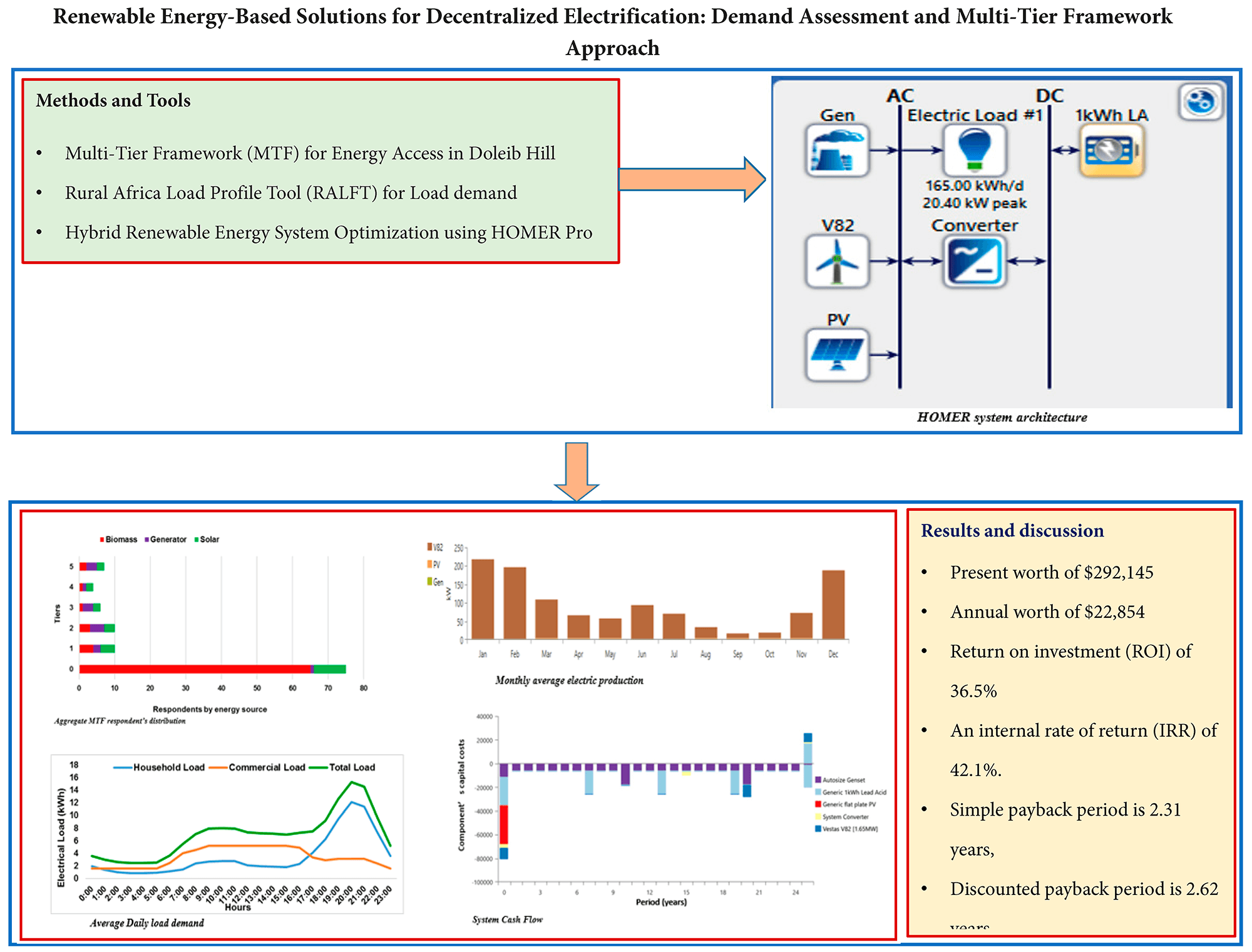
Keywords
1.1 Introduction to Energy Access in South Sudan
Access to reliable and sustainable energy plays a pivotal role in driving socioeconomic development. Sub-Saharan Africa continues to face significant challenges with electricity access. Fig. 1 presents a global population without access to electricity between 2010 to 2024. The population without electricity in the developing Asian countries had declined by nearly 90% signifying increase in generation capacity while a huge gap of electricity deficit is experienced in Sub-Saharan Africa during the period. About 80% of the world’s population without electricity is underdeveloped.
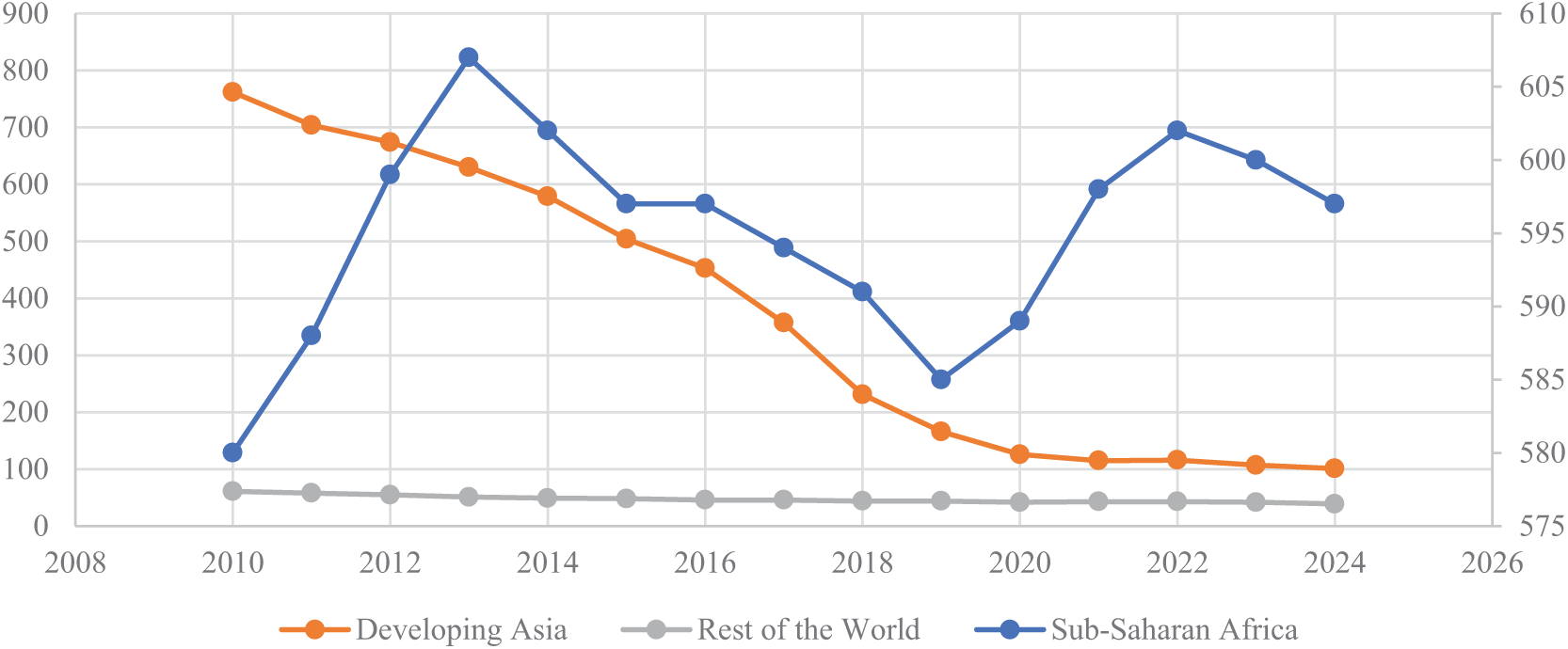
Figure 1: Variation of the global populations without access to electricity between 2010 to 2024
The situation in South Sudan is dire, as the country grapples with alarmingly low levels of electricity access, with only 7.4% of the population having access to electricity. Rural areas in South Sudan, such as Doleib Hill which is situated at 16 km from Malakal, faces significant challenges in meeting their energy needs. They heavily depend on expensive and environmentally detrimental sources of energy, such as diesel generators, kerosene lamps, and biomass. This energy shortage affects the economy and essential services like education and healthcare, lowering the quality of life among the communities [1–3].
1.2 Decentralized Electrification
Expanding South Sudan’s national grid to achieve universal access is not possible or cost-effective in the short term due to the current state of the country’s energy infrastructure. High costs, expansive geographical area, and low population density in rural areas hinder provision of electricity. However, in this context, decentralized electrification proves to be a practical alternative. It involves the utilization of localized energy solutions such as micro-grids, home systems, and mini-grids [4–6].
Decentralized electrification offers numerous advantages. It enables the customization of energy solutions to suit the unique requirements of individual communities. This approach can be swiftly implemented at a lower cost than grid expansion, making it suitable especially for remote areas. Furthermore, decentralized systems can harness renewable energy sources, offering a sustainable and environmentally friendly substitute for fossil fuels. This is not only aiding the reduction of the country’s carbon footprint but also reduces reliance on expensive and unreliable fuel imports [7,8].
South Sudan possesses substantial renewable energy resources, such as solar, wind, and hydropower. Embracing renewable energy for decentralized electrification offers numerous advantages. First, it reduces the country’s dependence on expensive imported fossil fuels, which can have unpredictable price changes and supply interruptions. Second, renewable energy can be adjusted to meet the energy needs of communities, like providing lighting, charging phones, and powering schools, healthcare facilities, and small businesses. Last but not least, renewable energy plays a crucial role in ensuring environmental sustainability by reducing emissions and mitigating deforestation effects [9,10].
Development of efficient renewable energy solutions for decentralized electrification calls for critical systematic approach. This approach involves assessing local renewable energy resources and selecting the appropriate technologies. Important factors include combining storage and distribution systems, involving local communities, and dealing with financial and regulatory challenges to ensure sustainability and compliance.
Ongoing monitoring and evaluation are crucial for optimizing performance and maintaining long-term sustainability. This approach focuses on demand assessment, which involves collecting data on energy usage, identifying unmet needs, and projecting future demand while taking into account factors such as population growth and economic activities [11–13].
The Multi-Tier Framework (MTF) for energy access enhances this process by offering a nuanced evaluation of energy access. Unlike the simple binary of “electrified” vs. “non-electrified,” the MTF assesses energy access across multiple tiers, considering aspects such as capacity, reliability, quality, affordability, and safety. Each tier represents a different level of energy service, from Tier 0 (no access) to Tier 5 (full access).
This multi-dimensional approach is especially valuable in regions with diverse energy needs, allowing for a detailed understanding of energy access and enabling tailored solutions. For instance, while some areas may only need basic services like lighting and phone charging (Tier 1), others may require more advanced services such as refrigeration and productive energy uses (Tier 4 or 5) (Brown & Garcia, 2023). This structured analysis supports the development of more effective and context-specific renewable energy solutions [14–16].
Tables 1 and 2 below depict a general detail for the Multi-Tier Framework (MTF) as proposed by the World Bank. This table outlines the different tiers of energy access assessment, including their service capacities, the type of services provided, and key indicators like availability, reliability, and quality.

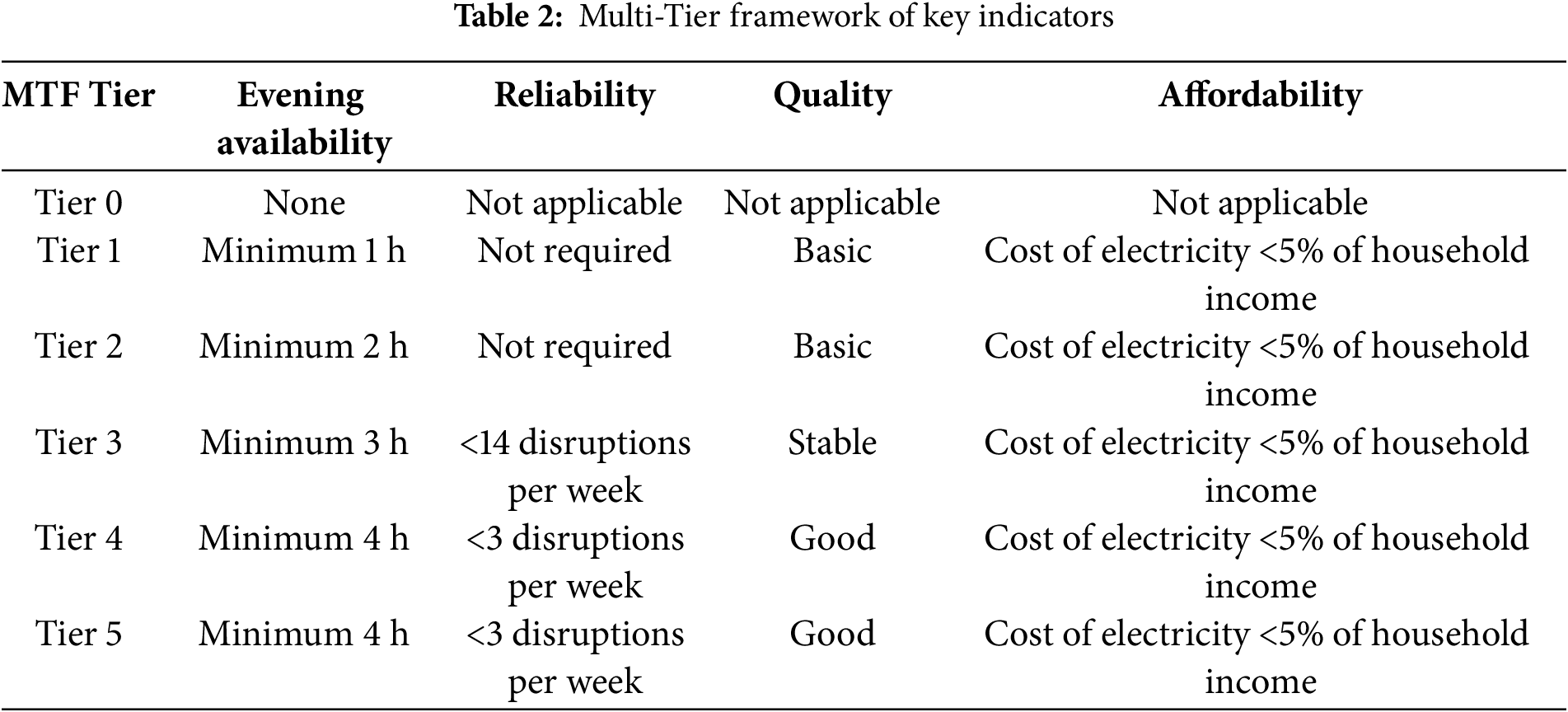
The Multi-Tier Framework (MTF) assesses various aspects of electricity service across different tiers. These solutions are but not limited to service capacity, which quantifies power available for use in waste. It determines the range of electrical devices that can be operated. Services provide different levels of support for appliances and services. Tier 1 offers basic lighting and phone charging, while Tier 5 provides full household electrification. Second is availability, when necessary, which comprises of daily Availability that refers to the number of hours electricity is accessible throughout the day and evening availability that refers to the evening hours when electricity is provided. This is necessary for activities like studying, cooking, and socializing.
Third is reliability, which measures the stability of the electricity supply by looking at how often disruptions occur. Lower tiers may tolerate frequent outages, whereas higher tiers require a more stable supply. Quality presents an assessment of electricity’s stability and effectiveness. While affordability will examine the cost of electricity, ensuring it remains affordable across all tiers, the aim is to keep electricity costs below 5% of household income to guarantee affordability.
This study focuses on the optical energy access challenges faced by rural communities in South Sudan, where electrification levels remain among the lowest globally. Communities like Doleib Hill Village rely heavily on costly, unsustainable energy sources like biomass and diesel generators. Renewable energy has great potential for providing electricity in a decentralized pattern. However, there is a lack of detailed research on how to implement these solutions in South Sudan. This research will assess demand in Doleib Hill village, using the Multi-Tier Framework to fill the gap.
The findings will help create a decentralized electrification plan that uses local renewable energy resources. This plan can be replicated in other off-grid areas in South Sudan. Moreover, this study will enrich the existing knowledge surrounding energy accessibility, providing valuable insights that can be used to develop policies and implement practical solutions [17–19]. Given the challenges and costs associated with centralized grid expansion, decentralized renewable energy systems offer a viable and sustainable alternative. This study fills a significant gap by designing a hybrid renewable energy system specifically tailored to meet the unique demands of rural South Sudanese communities.
This paper is structured as follows: Section 2 outlines the methodology, including data collection and analysis techniques. Section 3 presents the results with patterns of energy access in Doleib Hill village with concentration on renewable energy solutions and HOMER optimization characterized by technical and commercial outlook. Section 4 discusses system economic and optimization results. Section 5 concludes with highlights and impacts of a hybrid renewable energy system and future research. This is finally followed by Section 6 which shows the recommendation for future practical actions.
The novelty of this research lies in its application of the Multi-Tier Framework (MTF) alongside HOMER Pro software and the Rural African Load Profile Tool (RALPT) to design and optimize a hybrid energy solution for off-grid electrification in Doleib Hill Village, Upper Nile, South Sudan. Unlike previous studies in South Sudan and similar regions that focus on general energy assessments or individual renewable technologies, this study takes an integrated approach [3,20,21]. It combines MTF’s tiered energy access evaluation with HOMER Pro’s optimization tools and RALPT to design a hybrid system that incorporates solar PV, wind turbines, batteries, and a generator.
The RALPT enables a more accurate estimation of energy demand by providing region-specific load profiles, improving the design of energy systems to match local consumption patterns. This ensures that the hybrid system is both efficient and appropriately sized to meet both base and peak demand. This approach provides a more detailed understanding of energy needs across multiple tiers and aligns energy solutions with local demand, considering the region’s socio-economic and resource contexts. The hybrid model is tailored to the renewable resources available in Upper Nile and is designed to be cost-effective, reducing reliance on fossil fuels.
The research offers a replicable model for sustainable rural electrification, focusing on hybrid systems to enhance energy access in underserved regions of South Sudan and Africa. By integrating technology optimization and demand assessment, this study provides a scalable framework for renewable-based solutions, with potential to inform policy and community energy planning, addressing energy poverty in off-grid areas.
The study utilizes a mixed methods of approaches to assess decentralized electrification solutions in Doleib Hill, Malakal, South Sudan. By integrating both quantitative and qualitative data, the research aims at providing a comprehensive understanding of energy access challenges and the feasibility of renewable energy solutions. A multi-Tier framework will be employed to evaluate energy access levels and potential impacts of renewable technologies. The results will contribute to developing a model for decentralized electrification in rural South Sudan, offering a potential solution for bridging the energy access gap in similar communities across the country.
As shown in Fig. 2, Doleib Hill Village is located approximately 16 km southeast of Malakal, the capital of Upper Nile State, South Sudan, at 8.35° N latitude and 30.89° E longitude. The village has a diverse population, including returning refugees, internally displaced people, and long-term residents, who primarily rely on subsistence farming and small-scale trade. This rural community faces significant energy challenges, relying on traditional biomass and costly polluting diesel generators due to the absence of a centralized electricity grid.
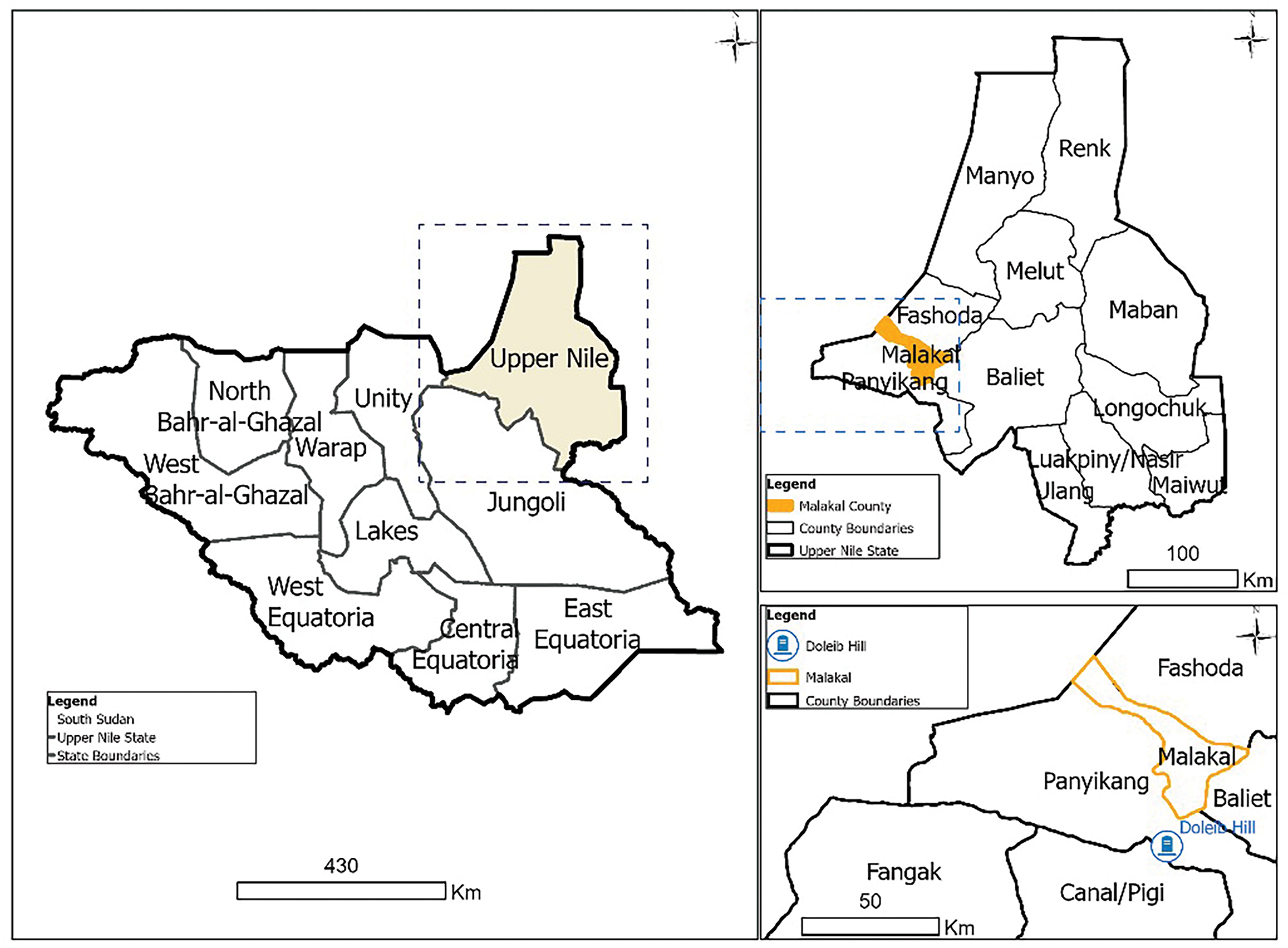
Figure 2: Map of South Sudan, Upper Nile State and Doleib Hill (Study Area)
The local distribution system which would extend to Doleib Hill from Malakal was vandalized during the war in 2013 and 2016. The lack of energy supply hinders the village’s economy, which depends on subsistence farming and small-scale trade. Additionally, the village lacks essential infrastructure and struggles with the lack of electricity.
To address these challenges, the use of wind and solar power presents a promising renewable energy solution. The implementation of solar home systems, wind turbines, and mini grids could significantly improve the quality of life and foster economic development in the village [22–24]. The data for wind and solar energy potential used in this study are sourced from Malakal Airport, providing localized insights for the region.
2.3 Data Collection and Analysis
2.3.1 Integration of Quantitative and Qualitative Data
Quantitative data has been collected through structured surveys conducted in households, NGOs, Public facilities, private sector and businesses in the selected village. These surveys have gathered extensive information about current energy usage, expenses, frequency, and duration of power outages. The collected data allows for assessing energy access across different levels, using a multi-level framework from basic to advanced [15,25,26]. To ensure the robustness of the survey data, the sample size was determined using the Cochran’s formula for a finite population, given by the following equation:
where:
•
•
•
•
•
Doleib Hill, previously abandoned due to conflict and flooding, is now seeing the return of displaced people. The village population, estimated at approximately 2150 people as of April 2024 according to UN data, was used to calculate the sample size for the study [27]. The average household size is appraised to be seven (7) people, leading to an estimated 308 households in the village. Applying Cochran’s formula, the required sample size was determined to be 102. Stratified random sampling was used to guarantee sufficient representation of different sub-groups within the population, including households and businesses. This method enabled a thorough analysis across diverse groups and ensured the survey results were comprehensive and representative [28,29].
Qualitative data were collected through in-depth, semi-structured interviews and focused group discussions. These engagements involved diverse local stakeholders, including government officials, community leaders, and residents. The methods explored views on energy access, challenges of using renewables, and the community’s preferred energy solutions [30,31].
The sample size for collecting qualitative data was determined by using data saturation. This point occurs when no new information emerges, ensuring a comprehensive understanding. Purposive sampling was used to select participants with specific knowledge or experience relevant to the research questions. Key informants and community members who had been actively involved in energy initiatives were targeted to provide in-depth insights [32–34].
Finally, to ensure the reliability and validity of the findings, the study has employed a triangulation approach. This approach combined quantitative and qualitative data sources. Combining various types of data improves credibility, reduces bias, and gives a thorough analysis of energy access problems [35–37].
2.3.2 Multi-Tier Framework Approach
The multi-tier framework will be used to categorize energy access into different levels based on the quality, quantity, and reliability of energy services [30]. Mapping of Current Energy Access using quantitative survey data to identify the current state of energy access in Doleib Hill, by categorizing households and businesses into different tiers based on their energy service quality and availability.
The evaluation of renewable energy solutions helps to assess how various renewable energy technologies can address the gaps identified in energy access. Qualitative insights from interviews and focus groups will provide additional context, highlighting community preferences and potential barriers. Modeling Scenarios using the combined quantitative and qualitative data to model potential scenarios for renewable energy deployment and estimate their impact on energy access levels. This integrated approach ensures a comprehensive assessment of both the current energy situation and the potential benefits of renewable energy solutions.
2.3.3 Renewable Energy-Based Solutions Analysis
An analysis of renewable energy solutions for decentralized electrification in Doleib Hill Village has been conducted to assess both technical feasibility and economic viability. The approach integrates tools and methodologies tailored to the specific energy demands of the region, including the use of Rural African Load Profile Tool (RALPT). The RALPT models and predicts energy consumption in rural Africa, where demand and supply differ from urban areas. This tool assists in the design of off-grid or mini-grid energy systems by offering realistic load profiles that reflect the typical consumption patterns, requirements, and constraints of rural communities.
a. Technical Feasibility
Hybrid Optimization Model for Electric Renewables (HOMER) Pro is a powerful microgrid optimization software and is widely used for designing and analyzing hybrid energy systems, including those integrating renewable energy sources like solar and wind. Originally developed at the National Renewable Energy Laboratory (NREL), HOMER Pro combines engineering and economic tools to help users identify the most cost-effective and reliable system configurations [38–40]. In the case of Doleib Hill Village, the utilization of HOMER Pro was pivotal in assessing and optimizing renewable energy systems, ensuring that they were tailored to the specific energy needs of both residential and commercial properties in the village.
Through the utilization and integration of RALPT, the energy solutions were strategically aligned with the community’s diverse energy demands, effectively catering to the unique energy usage patterns of local businesses [41–43]. The schematic representation of the hybrid power system designed, analyzed, and optimized within HOMER Pro is illustrated in Fig. 3. This figure captures the various components and interactions that constitute the entire system, which comprises five key components: photovoltaic (PV) solar panel, a wind turbine, a battery, a generator, and a converter.
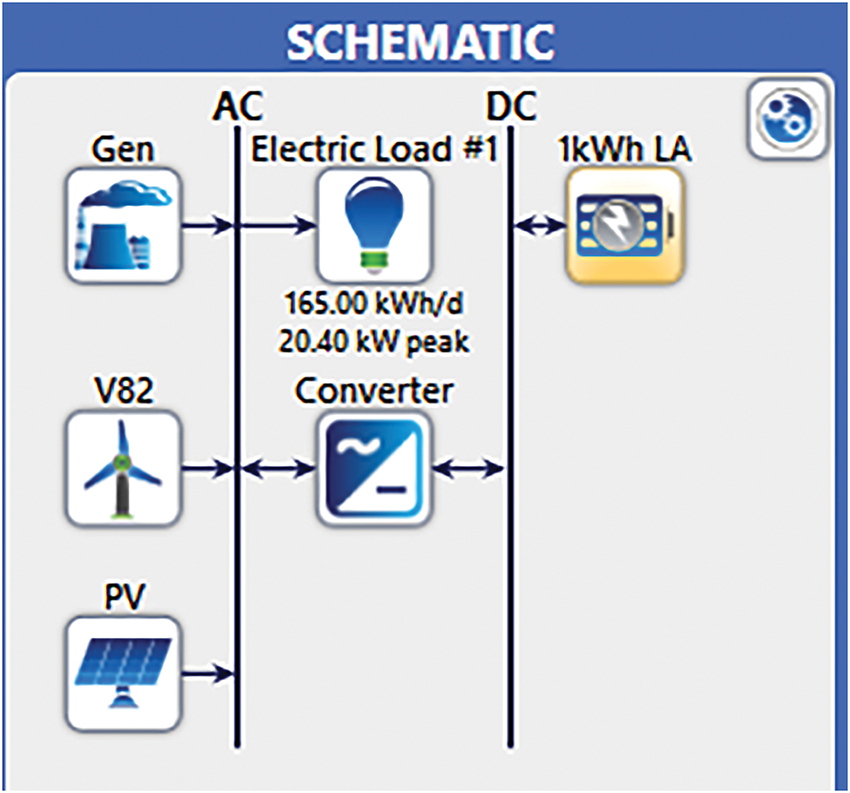
Figure 3: HOMER system architecture
The specifications for the components of the hybrid power system are outlined in Table 3, with each element selected to optimize both performance and cost-effectiveness. The photovoltaic array consists of generic PV modules designed to meet the load demand with costs adjusted for system balance and associated expenses. Similarly, wind turbines are chosen based on local wind resources and energy requirements, incorporating costs that encompass installation and maintenance. Additionally, a diesel generator serves as a reliable backup or complementary power source, with its expenses factoring in fuel, operation, and maintenance.
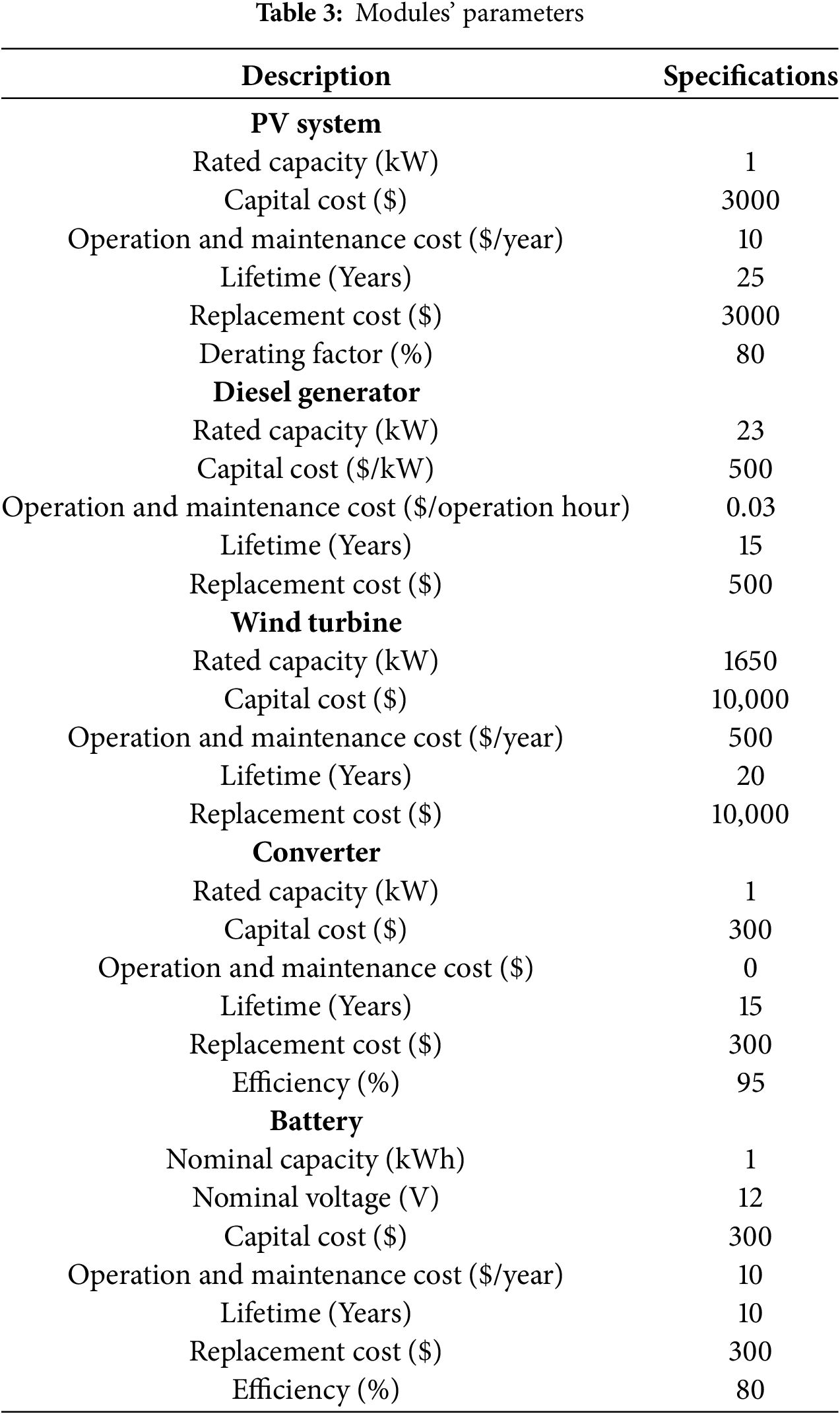
To ensure energy reliability, a lithium-ion battery is employed and integrated seamlessly through HOMER-Pro software, while a versatile converter from HOMER connects the DC and AC buses, facilitating seamless energy storage without the need for additional adjustments.
b. Economic Viability
A cost-benefit analysis and financial evaluation were conducted to determine the economic feasibility of the suggested renewable energy solutions. Excel was utilized to compute essential financial metrics like Net Present Value (NPV) and Internal Rate of Return (IRR). These techniques have been selected based on previous research and their suitability for analyzing the financial viability of renewable energy projects [44–46]. The economic assessment was designed to incorporate the energy demand profiles generated from integrating households and commercial loads. This approach ensures accurate calculation of projected financial returns for renewable energy systems in residential and commercial energy consumption patterns [43,47,48].
c. Total Net Present Cost (TNPC)
The NPC is given by the following formula:
where CC is the total capital cost,
d. Internal Rate of Return (IRR)
e. Levelized Cost of Energy (LCOE)
The LCOE is a key figure in the energy project. It measures the ratio of the NPV of total cost of the project over lifetime and NPV of electrical energy produced over lifetime of the project. The internal rate of return helps the company in making decisions on investment. LCOE and IRR are given by the following formulae [46,49]:
where CRF is the capital recovery factor,
In the absence of the grid,
where
f. Life Cycle Emissions
The quantity of the corresponding CO2 emissions in this study was calculated using the following formula:
where El (kWh) gives information about the amount of electricity generated in each system component, while Bi (kg CO2-eq/kWh) gives the system CO2 emission during lifetime and x represents the number of the components in the system.
Fig. 4 presents sensitivity analysis for the hybrid system which involves examination of how changes in different input variables impact the system’s overall performance and cost. This analysis helps in identifying the most critical factors that affect the system’s efficiency, reliability, and economic viability. Below is a step-by-step chart on how sensitivity analysis is performed for a hybrid system.
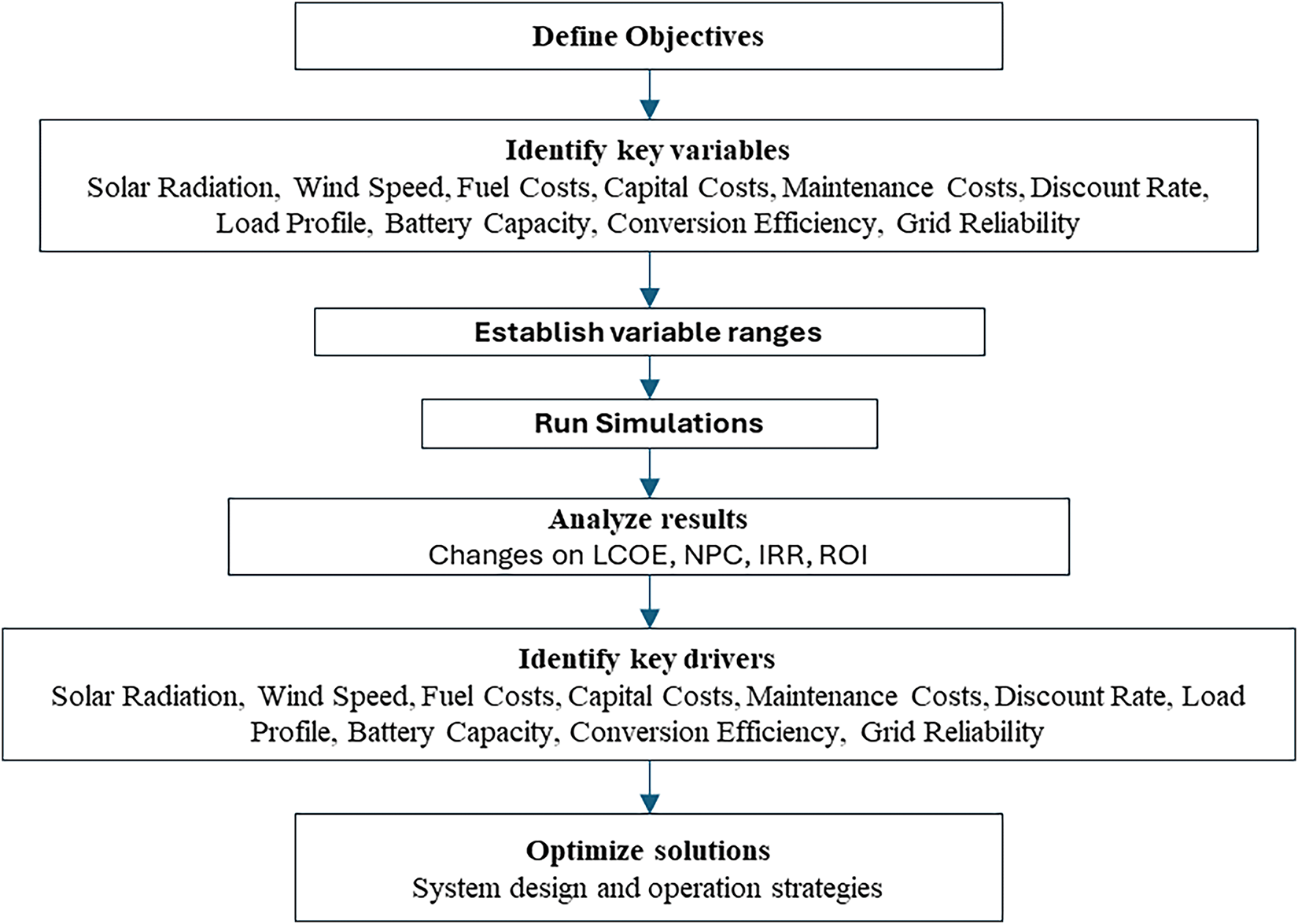
Figure 4: Sensitivity analysis of the hybrid system
Higher solar radiation and wind speed improve the performance of PV panels and wind turbines. Fuel costs increase operational expenses and affect the cost-effectiveness of the system. High capital costs impact on the financial feasibility and return on investment (ROI) of the system. Higher maintenance costs contribute to greater lifecycle costs, affecting the Net Present Cost (NPC) and levelized cost of energy (LCOE). Higher discount rates decrease the present value of future savings and revenues, impacting financial metrics like the internal rate of return (IRR).
An accurate load profile helps optimize the sizing and operation of system components, ensuring a reliable energy supply and cost efficiency. Higher battery capacity and efficiency enhance the system’s ability to store and dispatch energy, improving reliability and reducing energy wastage. Higher conversion efficiency reduces energy losses, enhancing overall system performance. Finally, a more reliable grid reduces dependency on the hybrid system, while an unreliable grid increases the need for robust hybrid system performance.
3.1 Energy Access in Doleib Hill Village
This section presents findings derived from questionnaires completed by a diverse range of respondents, including households, private entities, Non-Governmental Organizations (NGOs), and public sector representatives. These results provide an in-depth look into Doleib Hill Village’s energy landscape. The energy sources used by the community, including generators, solar power, charcoal, and collected wood, are explored. This assessment provides insight into the diverse means through which the village meets its energy needs, highlighting both the availability and limitations of each source.
The evaluation of energy access levels in Doleib Hill Village was conducted using the Multi-Tier Framework (MTF). The results, as shown in Fig. 5, indicate heavy reliance on biomass, especially at lower tiers, with limited access to modern energy solutions such as solar and generators. The findings revealed significant disparities across different tiers, ranging from complete reliance on traditional biomass sources to partial adoption of solar energy systems.

Figure 5: Aggregate MTF respondent’s distribution
A substantial 65% of respondents (65 out of 100) fall into Tier 0, relying predominantly on traditional energy sources such as wood, charcoal, and animal waste, with no access to modern electricity solutions. Only 1% of these respondents use generators, while 9% have access to small solar systems. This highlights the severe lack of modern energy access for most households in the village.
In Tiers 1 and 2, representing 10% of respondents (10 out of 100), households and private sector users have minimal access to small solar systems that provide basic services like lighting and phone charging. In these tiers, relative to all respondents, 7% of households rely on biomass, 6% on generators, and 7% on solar energy. However, these systems remain inadequate for more advanced energy needs, such as powering larger appliances or supporting businesses.
For Tiers 3 to 5, which include 25% of respondents (25 out of 100), there is a noticeable shift towards more reliable energy access, largely influenced by NGOs and public organizations. In these tiers, 4% of households use biomass, 7% use generators, and 6% rely on solar systems. These systems, while supporting multiple appliances and better meeting energy needs, are still primarily powered by diesel generators, which pose significant environmental and cost concerns.
To improve energy access across all tiers, expanding clean energy solutions like solar and wind power is essential. Offering subsidies and affordable financing for larger solar systems, alongside establishing community-level solar and wind-powered mini-grids, would ensure reliable and sustainable energy for households and businesses. This approach would reduce dependence on traditional biomass energy and diesel generators, enhancing energy availability while promoting cost efficiency and environmental sustainability for the community.
3.2 Doleib Hill Village’s Renewable Energy Solutions
Model Technical Analysis
To evaluate the feasibility of implementing an off-grid system to address the electricity access challenges in Doleib-Hill village, an off-grid electricity generation system was designed and analyzed to meet the estimated daily load demand, catering to both residential and commercial needs. This estimation was delivered from responses gathered through questionnaires, utilizing the RALPT, as illustrated in Table 3.
Table 4 percentages are derived by linking income levels to household tiers. Low-income households, corresponding to Tiers 0–2, make up 77.3% of the total 308 households, reflecting the widespread financial hardship. Medium-income households, in Tiers 3–4, account for 13.6%, representing a smaller but critical segment that faces moderate economic challenges. High-income households, classified as Tier 5, make up 9.1%, indicating a small group with greater financial resources. These percentages were calculated by applying the tier-based classification to the total number of households.
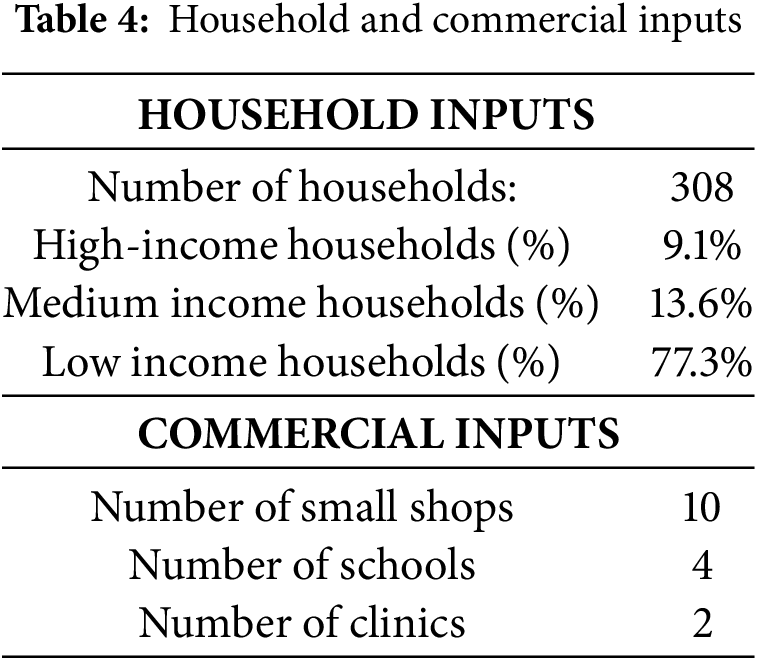
The daily electric load profiles, estimated at
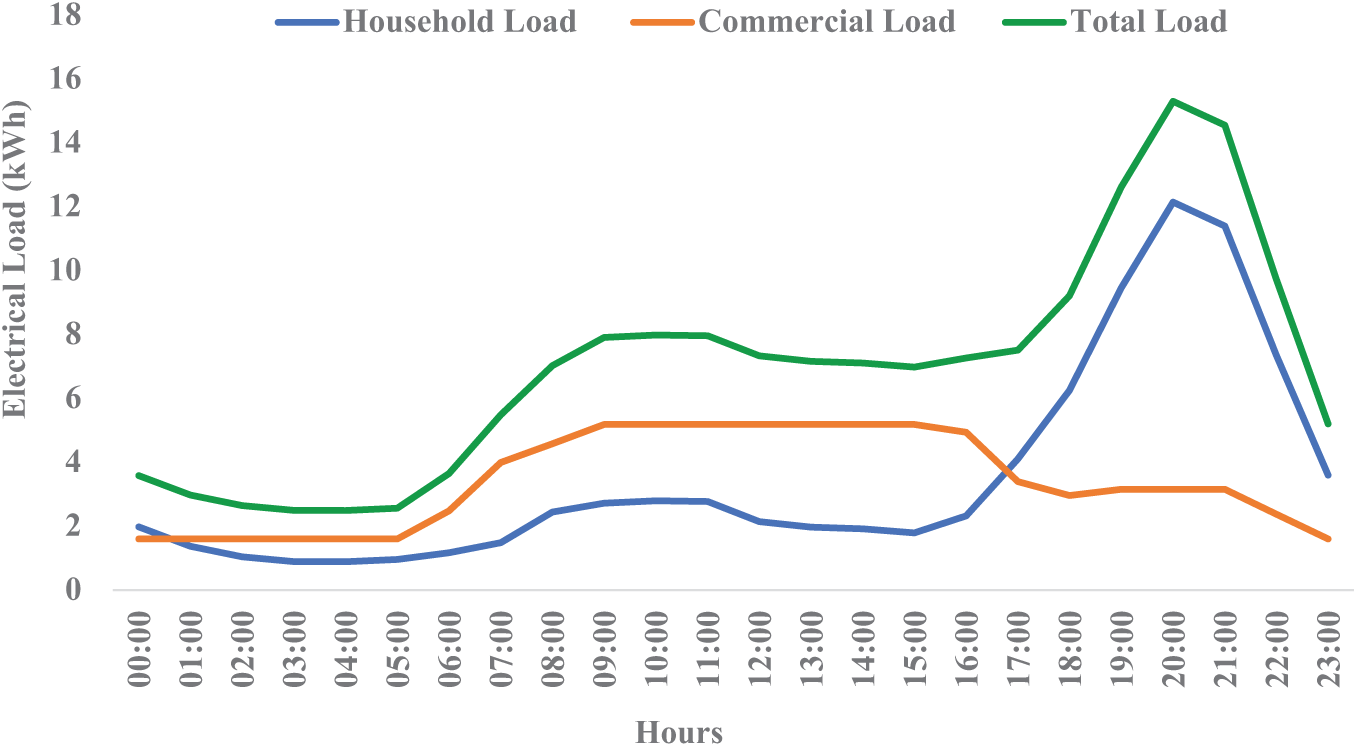
Figure 6: Daily load demand
In contrast, the evening sees a surge in electricity demand from 18:00 to 22:00, as households gather together. On the commercial side, peak usage occurs from 7:00 to 17:00, aligning with the operational and active hours of local businesses. Furthermore, the combined load profile reveals that overall electricity consumption peaks in the evening, particularly from 18:00 to 22:00, driven largely by household needs.
Figs. 7 and 8 display the monthly solar radiation and wind data, provided by South Sudan Meteorological Department, for the village of Doleib Hill. The village enjoys an average daily solar irradiation of around 5.43 kWh/m²/day, alongside a wind speed of 5.5 m/s, both of which exhibit notable seasonal and monthly fluctuations. This data has also been utilized as an input into HOMER software to simulate the optimal design of a hybrid renewable energy system.
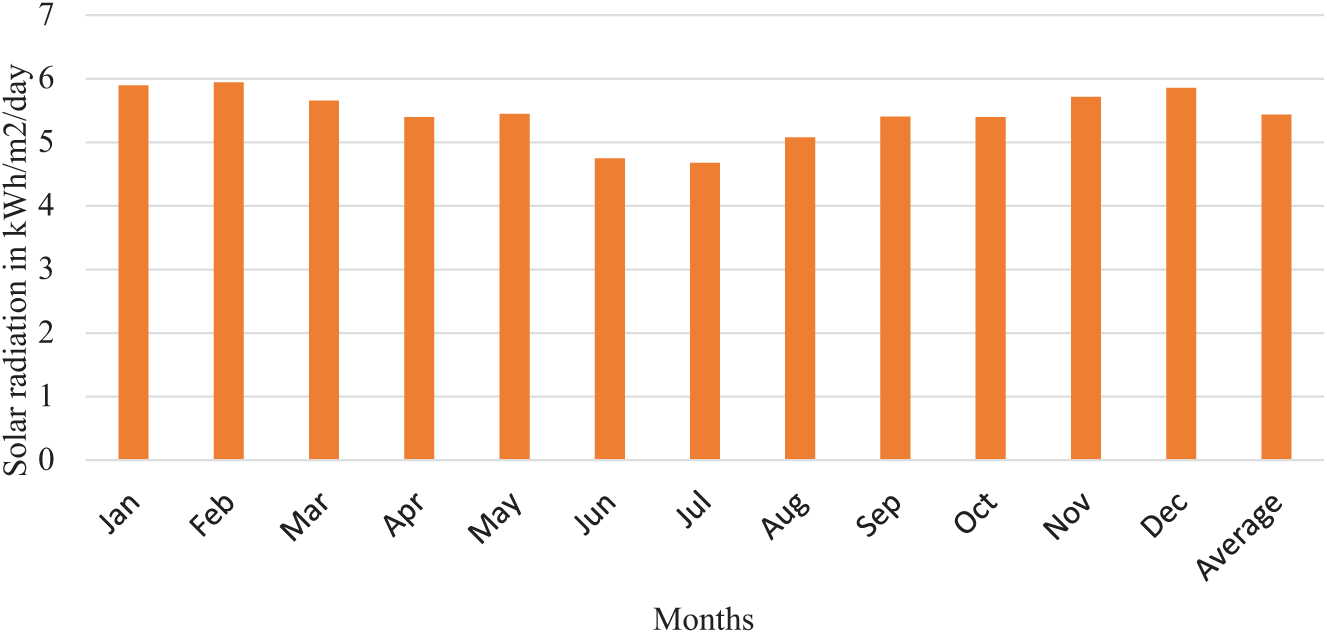
Figure 7: Monthly solar radiation
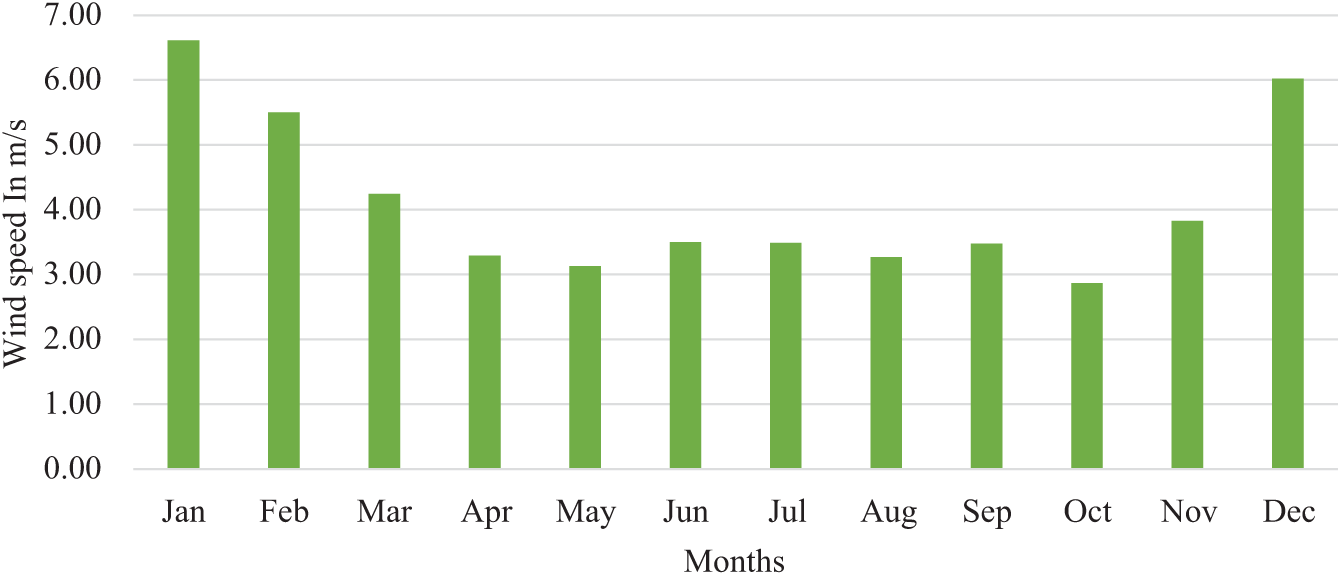
Figure 8: Monthly wind speeds at 10 m a.g.l
Tables 5–7 outline various hybrid system configurations that combine solar PV, wind turbines, generators, and battery storage to determine the best capacity and production efficiency for Doleib Hill Village. Each configuration evaluates production capacity (kW), fuel needs (L), and annual energy output (kWh/yr), aiming at balancing renewable energy generation with conventional backup to meet changing demands. For example, configurations such as “PV/Wind/Battery/Gen/Converter” integrate multiple energy sources, minimizing fuel dependence and ensuring a reliable energy supply. In contrast, setups that rely solely on generators, like “Gen,” result in elevated fuel costs and higher operational emissions. These meticulously optimized combinations provide design flexibility, considering production requirements, economic factors, and overall system sustainability. HOMER optimization results are acategorised into non-renewable and renewable energy sources as well as battery and converter within the hybrid system as presented in Tables 5–7.
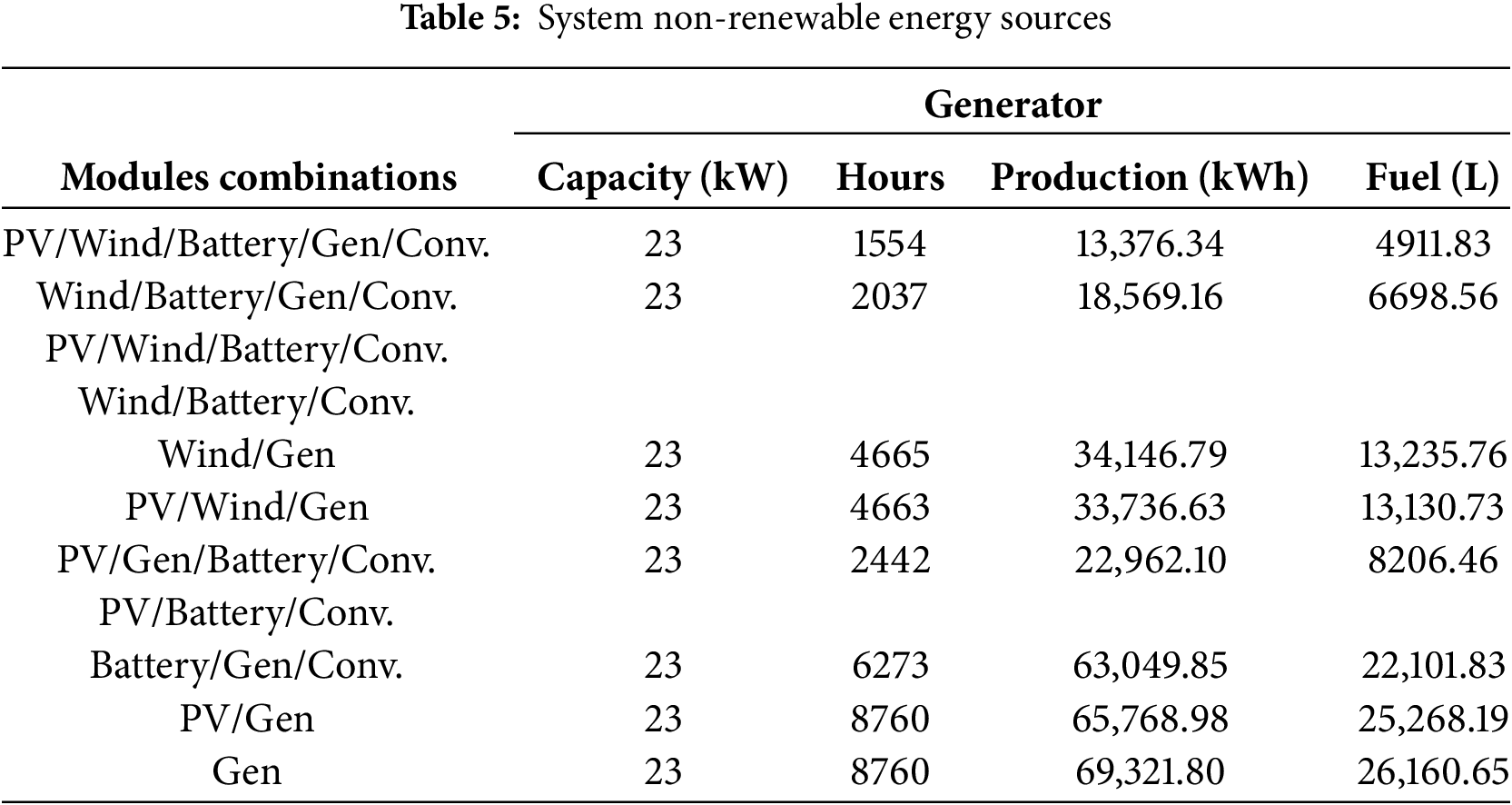
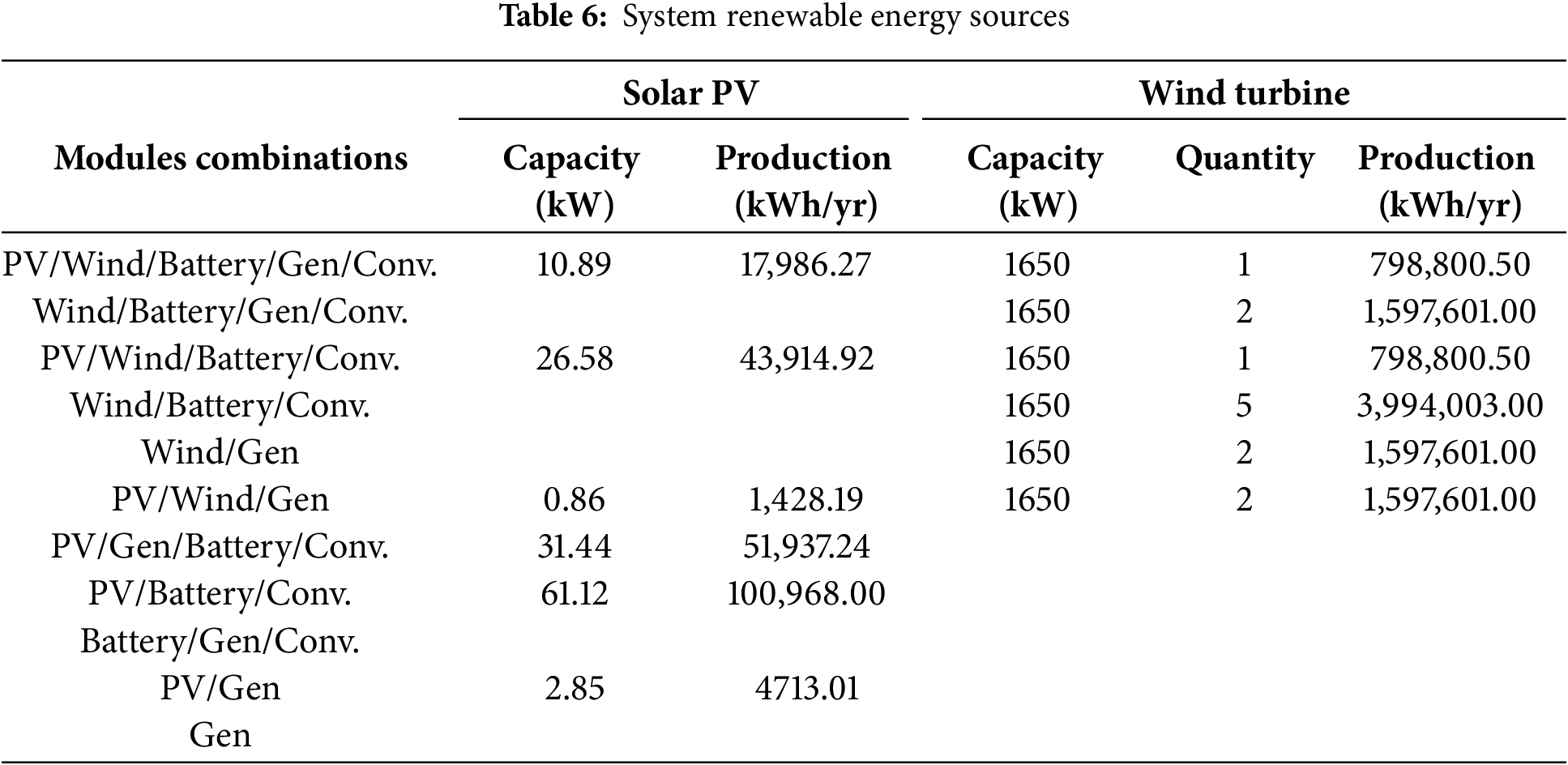
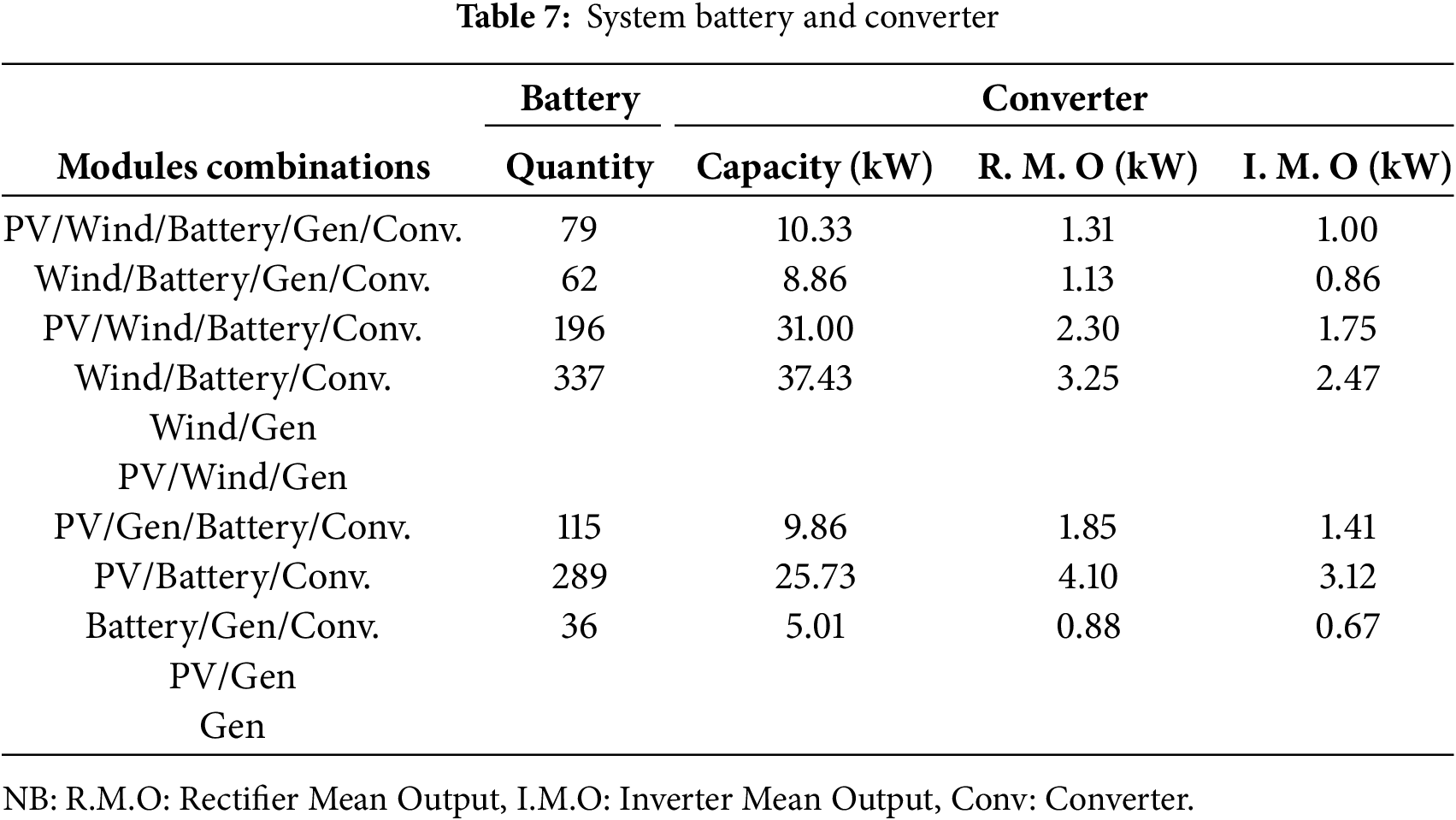
The economic analysis of the proposed hybrid energy systems evaluates financial viability through metrics like Net Present Cost (NPC), Cost of Energy (COE), and payback periods. The optimal system component—generator, solar PV, wind turbine, converter, and battery—is assessed for capital cost, salvage value, and total lifecycle costs. These evaluations provide insights into the potential return on investment and long-term sustainability of the energy systems. Ultimately, this information aids stakeholders in making informed decisions that align with their financial and environmental goals. This financial overview promotes a balance between initial costs and long-term savings, helping Doleib Hill Village achieve a sustainable energy solution.
A. System Optimization
Tables 8 and 9 provides an overview of operating costs, production output, and levelized cost of energy (LCOE) for different hybrid system configurations in Doleib Hill Village. The renewable energy system that combines solar PV, wind, generator, battery storage, and converter has a low LCOE of $0.276 per kWh and moderate operating costs, hence reduced fuel reliance. In contrast, systems that heavily rely on generators, such as the “Generator” configuration, face significantly increased operating costs of $38,574.22 annually and a Levelized Cost of Energy (LCOE) of $0.655 per kWh, primarily due to their constant fuel consumption.
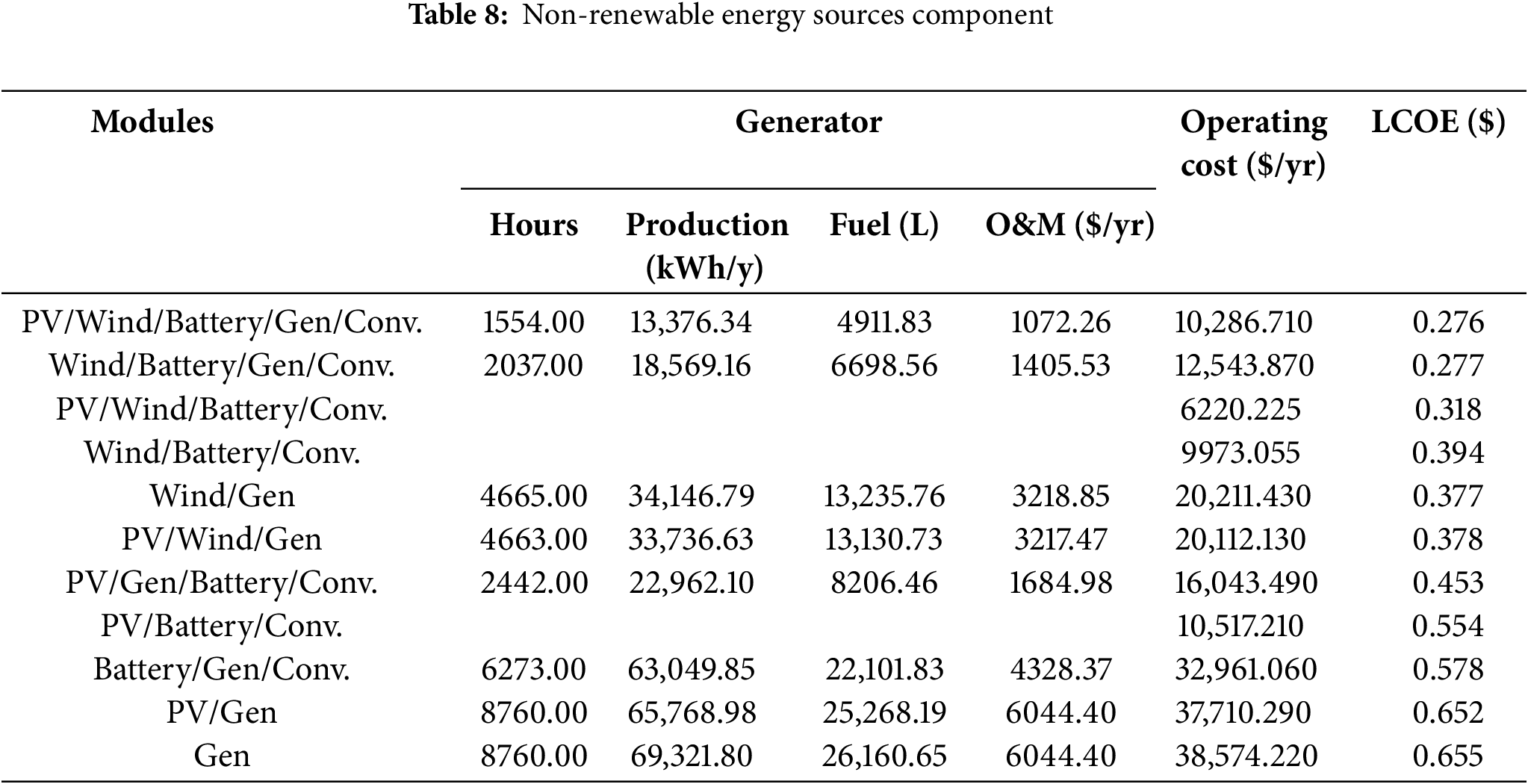
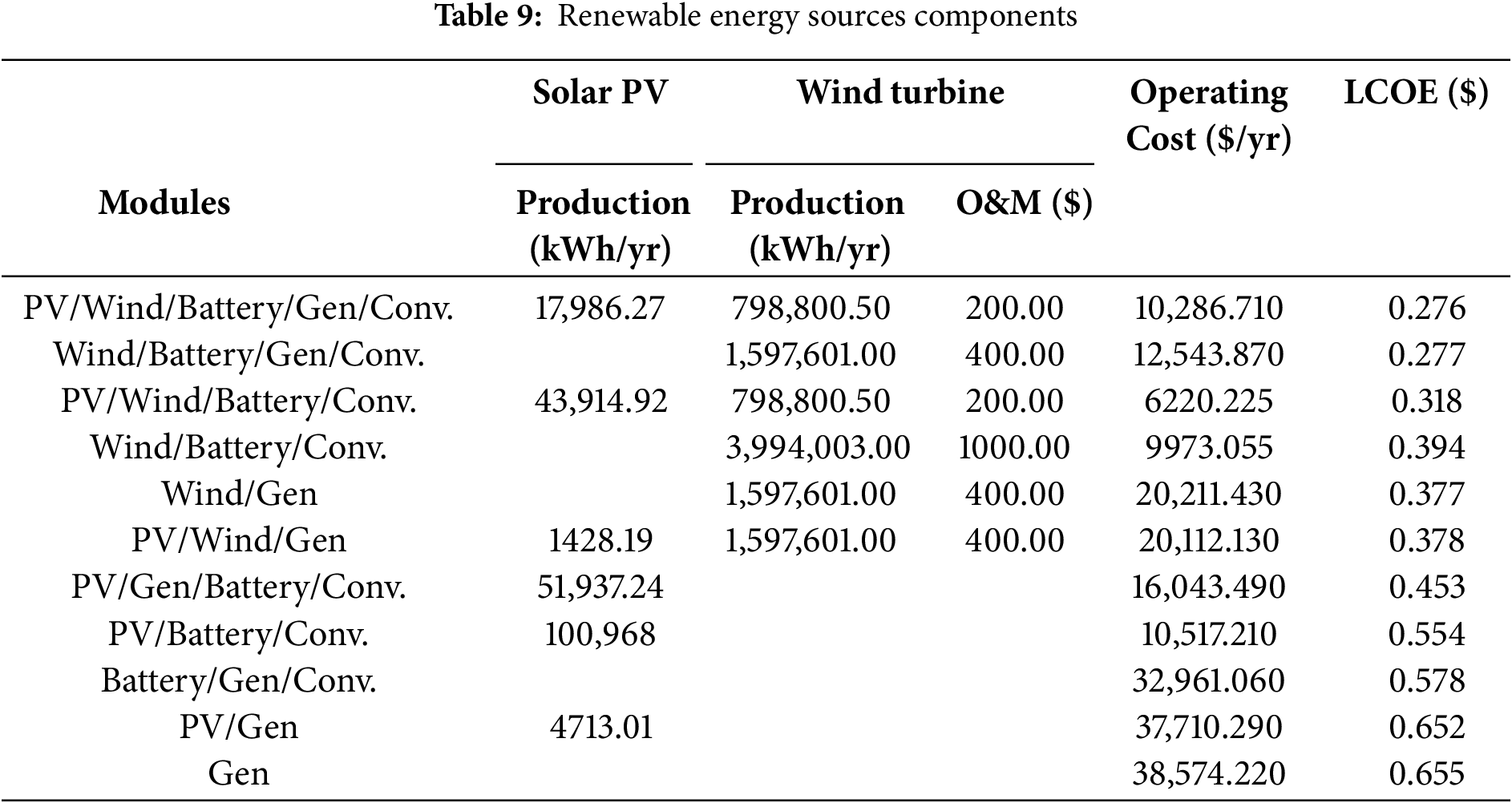
Moreover, configurations with constrained renewable input, such as “Wind/Battery/Gen/Conv.,” demonstrate moderate costs that underscore the need for regular generator operation. The table shows that hybrid systems focusing more on renewable resources have lower operating costs and improve economic efficiency. This supports the case for adopting renewable-inclusive systems as a viable, sustainable energy solution for the village.
B. System Optimization
C. System Optimization
Table 10 provides an in-depth analysis of the costs associated with the HOMER optimization results derived from various combinations of energy sources. This analysis highlights the impact of each energy source on the overall financial viability of the project. By comparing these costs, stakeholders can make informed decisions regarding the optimal energy mix for future implementations.
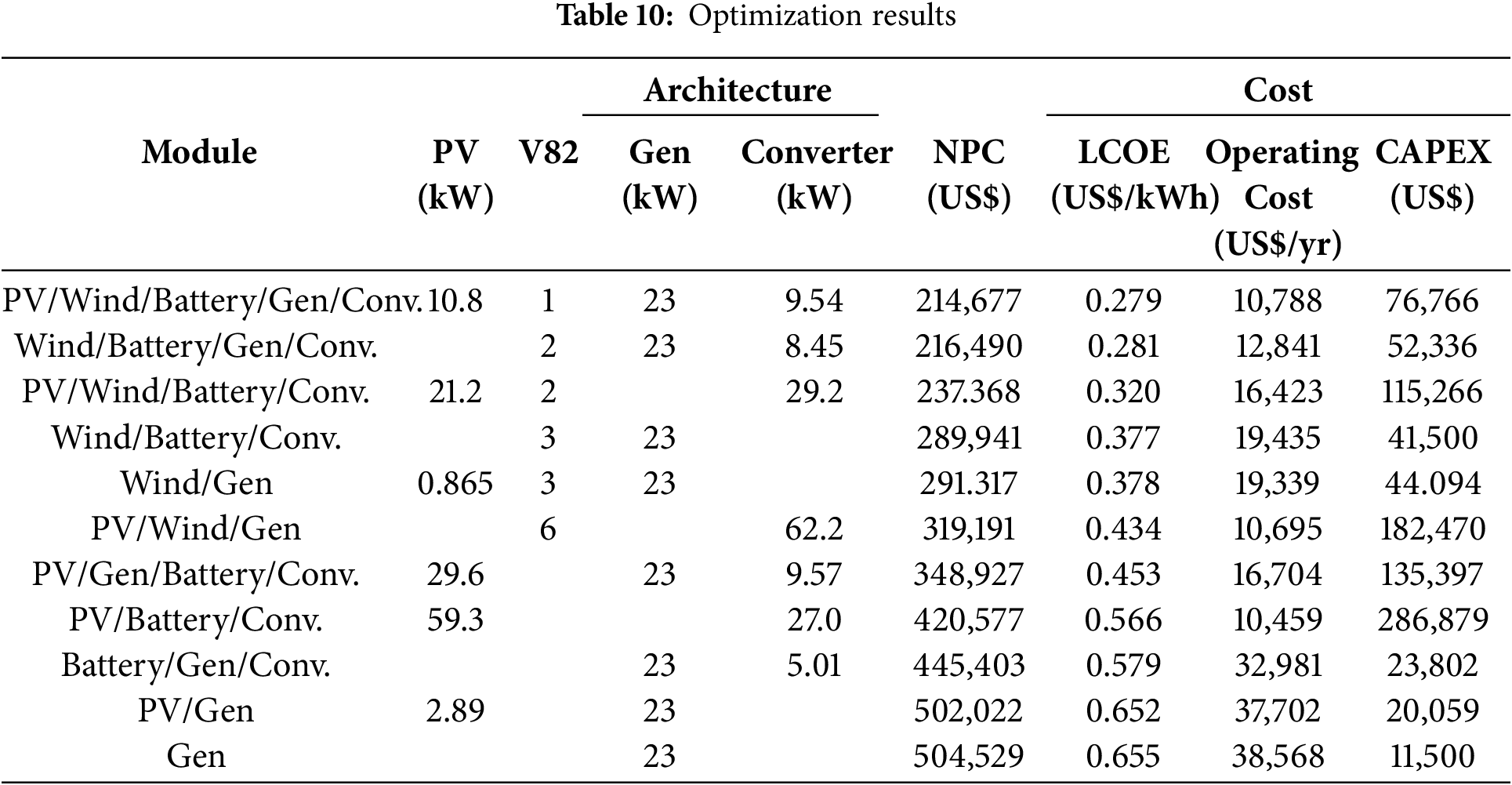
Fig. 9 presents the monthly average electric production of the hybrid energy system proposed for Doleib Hill Village. This figure shows the annual contribution of various components like solar PV, wind turbines, and generators to total electricity generation. The wind turbine at Doleib Hill Village proves that wind is a reliable energy source, generating 798,800 kWh/year. Higher production in January, February, and December suggests stronger winds during these months. Seasonal wind increases offset low solar energy during cloudy periods, highlighting wind’s crucial role in enhancing the hybrid energy system.

Figure 9: Monthly average electric production
Fig. 10 illustrates the financial implications of each component in the system, culminating in a Total Net Present Cost (TNPC) of $212,463.47 with capital cost of $80,965. This figure represents the comprehensive cost of the system, accounting for all capital investments, operational and maintenance expenses, replacement costs, and salvage values.
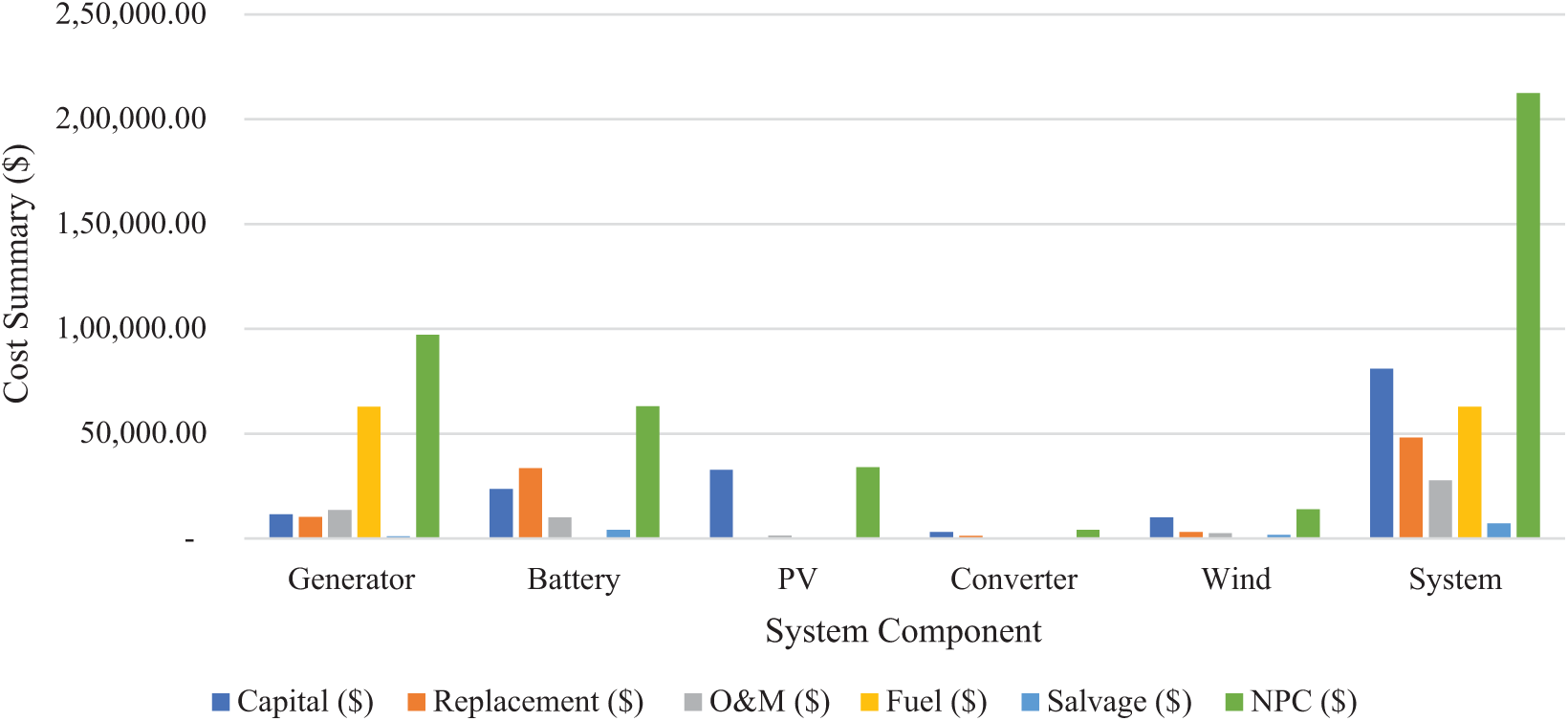
Figure 10: Optimal system costs details per component
• PV (Photovoltaic) systems demonstrate a low NPC of $34,057.06, reflecting their cost-effectiveness over time due to minimal operational and maintenance costs. This position is PV as an attractive option for long-term renewable energy solutions.
• The Generator incurs significant fuel costs of $62,789.73, leading to a high NPC of $97,185.05 despite its lower capital cost. This suggests a trade-off between initial investment and ongoing operational expenses.
• The Battery, while having a higher capital cost of $23,700.00, shows a competitive NPC of $63,141.93, primarily due to the absence of fuel costs. This indicates its viability as a long-term energy storage solution.
• The Converter stands out with the lowest NPC of $4152.20, demonstrating its cost-effectiveness relative to its capital and replacement costs.
• The V82 component, with a NPC of $13,927.23, indicates moderate costs that contribute to the overall system efficiency.
In conclusion, the strategic integration of these components exemplifies a thoughtful approach to reducing operational costs while enhancing energy production and reliability. This analysis underscores the significance of weighing both initial capital investments and long-term operational efficiencies when designing an energy system, ultimately guiding choices that align with both financial viability and environmental sustainability.
Table 11 provides key financial metrics for project evaluation. It shows a present worth of $292,145, representing the total current value of future cash flows. The annual worth is $22,854, indicating the equivalent uniform annual cash flow. The return on investment (ROI) is 36.5%, demonstrating the project’s profitability relative to its initial cost. The internal rate of return (IRR) is 42.1%, which is the discount rate at which the net present value of cash flows equals zero. The simple payback period is 2.31 years, indicating the time it takes to recover the initial investment without considering the time value of money. The discounted payback period is 2.62 years, reflecting the time to get back the investment with adjustments for the time value of money.
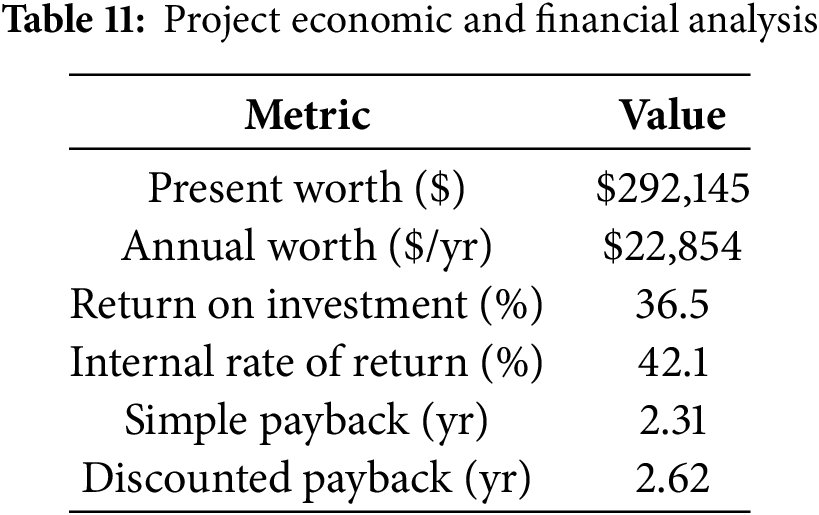
Fig. 11 visualizes the cash flow of the renewable energy system over a 25-year period, highlighting initial capital costs for components like solar PV panels, wind turbines, batteries, and generators. It also details periodic maintenance and replacement costs, showing higher initial costs for long-lasting components such as solar PV (25 years) and wind turbines (20 years), compared to shorter-lived assets like batteries (7 years) and generators (10 years). This figure emphasizes the financial planning required for sustainable operation and eventual component replacement, ensuring the project’s financial sustainability and operational efficiency.
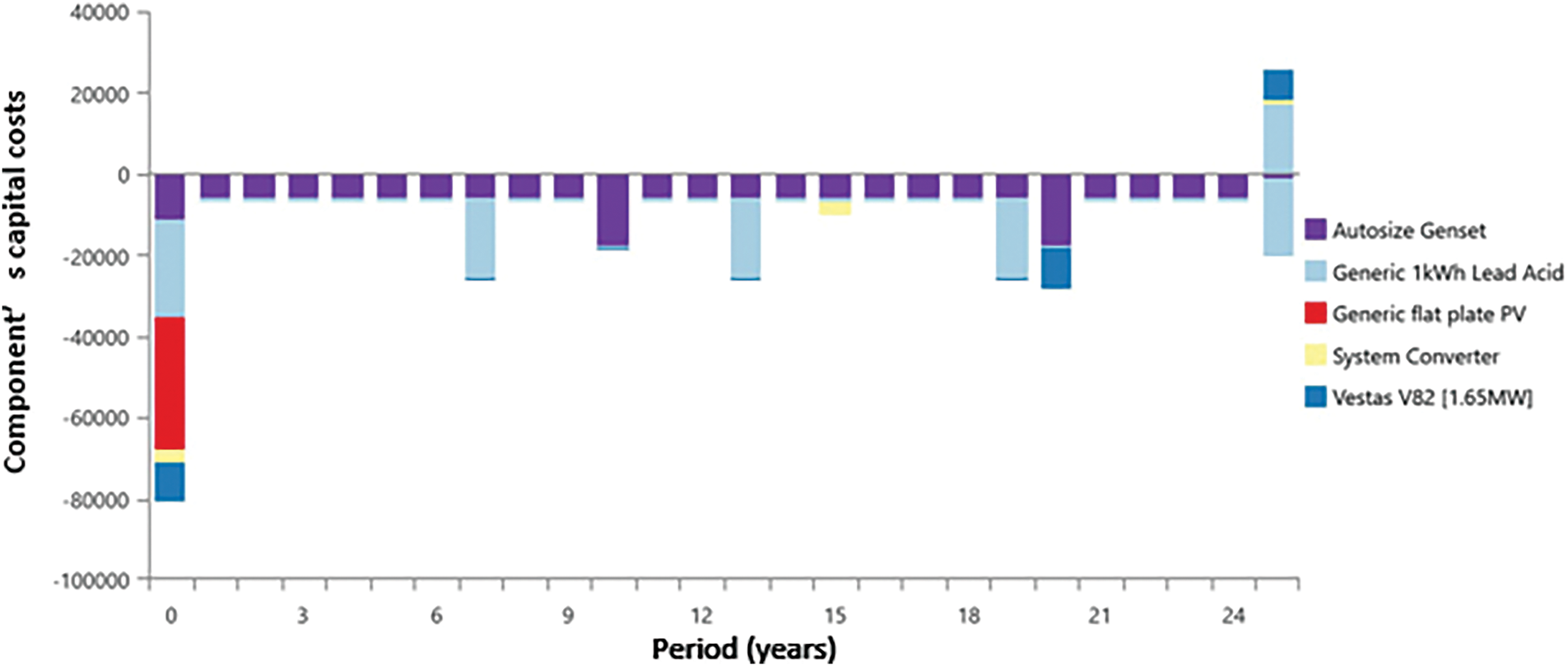
Figure 11: System cash flow
The study highlights the feasibility and impact of a hybrid renewable energy system incorporating solar PV, wind turbines, batteries, and diesel generators to provide sustainable, decentralized electrification in Doleib Hill Village, South Sudan. The system, optimized using the Multi-Tier Framework (MTF) and HOMER Pro software, meets local energy demands in a reliable, cost-effective, and environmentally friendly manner. Financially, the system is robust, with a present worth of $292,145, an annual worth of $22,854, a return on investment (ROI) of 36.5%, and an internal rate of return (IRR) of 42.1%. The short payback periods, 2.31 years (simple) and 2.62 years (discounted)—further underscore its economic viability, making it attractive for rural electrification initiatives. The hybrid system also offsets diesel use by harnessing an estimated 798,800 kWh of wind energy annually, enhancing sustainability and reducing emissions. This model presents a replicable pathway for rural electrification, promoting progress toward Sustainable Development Goal 7 (affordable and clean energy) and fostering socioeconomic growth through improved access to education, healthcare, and local businesses.
The Multi-Tier Framework for Energy Access measures holistic patterns of data access, however, it comes with detailed data collection and implementation complexities which are resource intensive compared with traditional binary assessment. Future research should look at integrating the data with the country’s national household surveys which could enhance sustainable data collection. It should also carryout an in-depth study on the differences in energy access between female and male headed households to guide interventions in addressing gender specific barriers in energy. Researchers may also investigate the potential hybrid systems’ integration with smart grids and evaluate enhancement of their functionality. This includes studying communication protocols, data management, and real-time monitoring to optimize energy distribution and usage. A comprehensive study on the economic and environmental impacts of hybrid systems should be investigated as it can provide insights into their long-term viability.
The research recommends the following key points for knowledge, investments and policy decisions:
1. The nationwide success of this pilot project will require similar hybrid systems to be scaled up, replicated, and tailored for off-grid communities across South Sudan and other regions in Africa. A need to customize each implementation based on local resource availability, community needs, and load profiles to ensure adaptability and maximize impact.
2. Governments and international donors should incentivize investment in renewable energy projects through subsidies, low-interest loans, and tax breaks, especially for low-income rural areas. These mechanisms can reduce initial costs, making renewable systems more accessible and financially viable for both communities and investors.
3. To foster long-term sustainability, local community members should be engaged in the project from planning through implementation. Training residents to operate and maintain the system can build local expertise and enhance ownership, reducing their dependency on external support.
4. Establishing a framework for regular data collection and monitoring of energy consumption, system performance, and economic impacts will enable continuous optimization and provide valuable insights for future projects. Such data can also help in adjusting the system to meet evolving community needs and scale up appropriately.
5. Policymakers should incorporate decentralized renewable energy systems into national energy plans as a key strategy for rural electrification. Clear and supportive policies for renewable mini-grids and microgrids can facilitate investment, streamline regulatory approvals, and create a conducive environment for sustainable development.
Through these recommendations, stakeholders can effectively leverage hybrid renewable systems to enhance energy access, foster economic development, and support environmental sustainability in underserved communities across South Sudan and similar regions.
Acknowledgement: The authors acknowledge the guidance provided by ACEESD, which facilitated the research. I also appreciate the South Sudan Malakal and Doleib Hill authorities for facilitating provision of the data.
Funding Statement: The authors received no specific funding for this study.
Author Contributions: Data collection, draft manuscript preparation, analysis and interpretation of results: Jacob Manyuon Deng; Manuscript comments, review and feedback: Cyrus Wabuge Wekesa, Khan Jean De Dieu Hakizimana, and Joseph Nzabahimana. All authors reviewed the results and approved the final version of the manuscript.
Availability of Data and Materials: Data available upon request from the author.
Ethics Approval: Not applicable.
Conflicts of Interest: The authors declare no conflicts of interest to report regarding the present study.
References
1. Ayik A, Ijumba N, Kabiri C, Goffin P. Preliminary assessment of small hydropower potential using the Soil and Water Assessment Tool model: a case study of Central Equatoria State, South Sudan. Energy Rep. 2023;9:2229–46. doi:10.1016/j.egyr.2023.01.014. [Google Scholar] [CrossRef]
2. IEA. Access to electricity improves slightly in 2023, but still far from the pace needed to meet SDG7. [cited 2025 Jan 1]. Available from: https://www.iea.org/commentaries/access-to-electricity-improves-slightly-in-2023-but-still-far-from-the-pace-needed-to-meet-sdg7. [Google Scholar]
3. Ayik A, Ijumba N, Kabiri C, Goffin P. Techno-economic modeling of stand-alone solar photovoltaic systems: a case scenario from South Sudan. SAIEE Africa Res J. 2024;115(2):55–68. doi:10.23919/SAIEE.2024.10520213. [Google Scholar] [CrossRef]
4. Amogpai AY. Current and future trends of electricity service in South Sudan. J Phys Conf Ser. 2024;2777(1):012001. doi:10.1088/1742-6596/2777/1/012001. [Google Scholar] [CrossRef]
5. Bhattacharyya SC, Palit D. Mini-grid based off-grid electrification to enhance electricity access in developing countries: what policies may be required? Energy Policy. 2016;94(10):166–78. doi:10.1016/j.enpol.2016.04.010. [Google Scholar] [CrossRef]
6. Peters R, Berlekamp J, Kabiri C, Kaplin BA, Tockner K, Zarfl C. Sustainable pathways towards universal renewable electricity access in Africa. Nat Rev Earth Environ. 2024;5(2):137–51. doi:10.1038/s43017-023-00501-1. [Google Scholar] [CrossRef]
7. Domegni KMS, Azouma YO. Productive uses of energy: a solution for promoting energy justice in rural areas in West Africa. Renew Sustain Energy Rev. 2022;160(926):112298. doi:10.1016/j.rser.2022.112298. [Google Scholar] [CrossRef]
8. International Energy Agency (IEA). World Energy Outlook 2023. Paris, France: International Energy Agency (IEA); 2023. [Google Scholar]
9. Charles RKJ, Majid MA. Advances and development of wind-solar hybrid renewable energy technologies for energy transition and sustainable future in India. Energy Environ. 2024;35(5):2517–65. doi:10.1177/0958305X231152481. [Google Scholar] [CrossRef]
10. Shi Z, Liang F, Pezzuolo A. Renewable energy communities in rural areas: a comprehensive overview of current development, challenges, and emerging trends. J Clean Prod. 2024;484(5):144336. doi:10.1016/j.jclepro.2024.144336. [Google Scholar] [CrossRef]
11. Qiu K, Entchev E. Modeling, design and optimization of integrated renewable energy systems for electrification in remote communities. Sustain Energy Res. 2024;11(1):10. doi:10.1186/s40807-024-00103-5. [Google Scholar] [CrossRef]
12. Grosspietsch D, Saenger M, Girod B. Matching decentralized energy production and local consumption: a review of renewable energy systems with conversion and storage technologies. Wiley Interdiscip Rev Energy Environ. 2019;8(4):1–18. doi:10.1002/wene.336. [Google Scholar] [CrossRef]
13. Khalid R, Landini S, Das Valasai G, Khalid F, Sandwell P. Towards equitable and inclusive energy systems for remote off-grid communities: a socio-technical assessment of solar power for village Helario in Tharparkar. Pakistan Renew Sustain Energy Transit. 2023;4:100067. doi:10.1016/j.rset.2023.100067. [Google Scholar] [CrossRef]
14. BANGLADESH. Beyond connections: energy access redefined. [cited 2025 Jan 1]. Available from: https://mtfenergyaccess.esmap.org/data/files/download-documents/full_report_beyond_connection.pdf. [Google Scholar]
15. Narlanka SR, Balachandra P. Measuring energy access for livelihoods, lifestyles, and welfare: validating the Hierarchical Energy Access Framework in India. Energy Res Soc Sci. 2024;107:103352. doi:10.1016/j.erss.2023.103352. [Google Scholar] [CrossRef]
16. Lahnaoui A, Venghaus S, Kuckshinrichs W. Assessing the drivers of energy supply and demand in Sub-Saharan Africa. Energy Strateg Rev. 2024;54:101483. doi:10.1016/j.esr.2024.101483. [Google Scholar] [CrossRef]
17. Trompette P, Etienne E, Francius R. At the margins of the grid: the politics of off-grid electrification in senegal. In: Ojong N, editor. Off-grid solar electrification in Africa. London, UK: Palgrave Macmillan; 2022. p. 65–110. doi:10.1007/978-3-031-13825-6_3. [Google Scholar] [CrossRef]
18. Gonçalves DNS, Bandeira RADM, Costa MGD, Goes GV, Assis TFD, D’Agosto MDA, et al. A multitier approach to estimating the energy efficiency of urban passenger mobility. Sustainability. 2020;12(24):24. doi:10.3390/su122410263. [Google Scholar] [CrossRef]
19. Asuamah EY, Gyamfi S, Dagoumas A. Potential of meeting electricity needs of off-grid community with mini-grid solar systems. Sci Afr. 2021;11(6):e00675. doi:10.1016/j.sciaf.2020.e00675. [Google Scholar] [CrossRef]
20. Ladu NSD, Samikannu R, Gebreslassie KG, Sankoh M, Hakim LER, Badawi A, Latio TPB. Feasibility study of a standalone hybrid energy system to supply electricity to a rural community in South Sudan. Sci Afr. 2022;16(1):e01157. doi:10.1016/j.sciaf.2022.e01157. [Google Scholar] [CrossRef]
21. SIslam MA, Saiful IM, Sabrina PS, Kumar MS. Comparative techno-economic analyses and optimization of standalone and grid-tied renewable energy systems for South Asia and Sub-Saharan Africa. Results Eng. 2024;21(3):101964. doi:10.1016/j.rineng.2024.101964. [Google Scholar] [CrossRef]
22. García-Vázquez CA, Espinoza-Ortega H, Llorens-Iborra F, Fernández-Ramírez LM. Feasibility analysis of a hybrid renewable energy system with vehicle-to-home operations for a house in off-grid and grid-connected applications. Sustain Cities Soc. 2022;86:104124. doi:10.1016/j.scs.2022.104124. [Google Scholar] [CrossRef]
23. Adetunla A, Rominiyi O, Adaramola B, Adeoye A. Development of a wind turbine for a hybrid solar-wind power system. Heliyon. 2022;8(11):e11458. doi:10.1016/j.heliyon.2022.e11458. [Google Scholar] [PubMed] [CrossRef]
24. Chang KC, Hagumimana N, Zheng J, Asemota GNO, Niyonteze JDD, Nsengiyumva W, et al. Standalone and minigrid-connected solar energy systems for rural application in Rwanda: an in situ study. Int J Photoenergy. 2021;2021(1):1211953. doi:10.1155/2021/1211953. [Google Scholar] [CrossRef]
25. Peters J, Sievert M, Toman MA. Rural electrification through mini-grids: challenges ahead. Energy Policy. 2019;132(5):27–31. doi:10.1016/J.ENPOL.2019.05.016. [Google Scholar] [CrossRef]
26. Vavouris A, Guasselli F, Stankovic L, Stankovic V, Gram-Hanssen K, Didierjean S. A complex mixed-methods data-driven energy-centric evaluation of net-positive households. Appl Energy. 2024;367(1):123404. doi:10.1016/j.apenergy.2024.123404. [Google Scholar] [CrossRef]
27. Mozersky D, Kammen DM. South Sudan’s renewable energy potential. In: Biong L, Kuol D, Logan S, editors. The struggle for South Sudan: challenges of security and state formation. I.B. Tauris; 2018. p. 243–61. doi:10.5040/9781788316361.ch-013. [Google Scholar] [CrossRef]
28. Ahmad S, Shabbir J, Emam W, Zahid E, Aamir M, Khalid M, et al. An improved class of estimators for estimation of population distribution functions under stratified random sampling. Heliyon. 2024;10(7):e28272. doi:10.1016/j.heliyon.2024.e28272. [Google Scholar] [PubMed] [CrossRef]
29. Ahmad S, Al Mutairi A, Nassr SG, Alsuhabi H, Kamal M, Ur Rehman M. A new approach for estimating variance of a population employing information obtained from a stratified random sampling. Heliyon. 2023;9(11):e21477. doi:10.1016/j.heliyon.2023.e21477. [Google Scholar] [PubMed] [CrossRef]
30. Zou C, Zhao Q, Zhang G, Xiong B. Energy revolution: from a fossil energy era to a new energy era. Nat Gas Ind. 2016;36(1):1–10. doi:10.1016/j.ngib.2016.02.001. [Google Scholar] [CrossRef]
31. Lennon B, Dunphy NP, Sanvicente E. Community acceptability and the energy transition: a citizens’ perspective. Energy Sustain Soc. 2019;9(1):1–18. doi:10.1186/s13705-019-0218-z. [Google Scholar] [CrossRef]
32. Rahimi S, khatooni M. Saturation in qualitative research: an evolutionary concept analysis. Int J Nurs Stud Adv. 2024;6(1):100174. doi:10.1016/j.ijnsa.2024.100174. [Google Scholar] [PubMed] [CrossRef]
33. Katumbi A, Musembi K. Effect of employees’ soft skills on performance of public energy sector. Int Acad J Hum Resour Bus Adm. 2018;3(2):1–3. [Google Scholar]
34. Owusu-Manu DG, Adjei TK, Sackey DM, Edwards DJ, Hosseini RM. Mainstreaming sustainable development goals in Ghana’s energy sector within the framework of public-private partnerships: challenges, opportunities and strategies. J Eng Des Technol. 2020;19(3):605–24. doi:10.1108/JEDT-06-2020-0255. [Google Scholar] [CrossRef]
35. Manwell JF, McGowan JG, Rogers AL. Wind energy explained: theory, design and application. 2nd ed. Hoboken, NJ, USA: John Wiley & Sons, Inc.; 2009. [Google Scholar]
36. Ohueri CC, Masrom MAN, Habil H, Ambashe MS. IoT-based digital twin best practices for reducing operational carbon in building retrofitting: a mixed-method approach. Eng Constr Archit Manag. 2023;32(3):2044–65. doi:10.1108/ECAM-08-2023-0827. [Google Scholar] [CrossRef]
37. Ahlborg H, Hammar L. Drivers and barriers to rural electrification in Tanzania and Mozambique—Grid-extension, off-grid, and renewable energy technologies. Renew Energy. 2014;61:117–24. doi:10.1016/j.renene.2012.09.057. [Google Scholar] [CrossRef]
38. Pürlü M, Andiç C, Aydın E, Solak B. Optimal design of hybrid renewable energy system for a region in turkey using HOMER. Turkish J Electr Power Energy Syst. 2023;3(3):146–55. doi:10.5152/tepes.2023.23021. [Google Scholar] [CrossRef]
39. Sen R, Bhattacharyya SC. Off-grid electricity generation with renewable energy technologies in India: an application of HOMER. Renew Energy. 2014;62(3):388–98. doi:10.1016/j.renene.2013.07.028. [Google Scholar] [CrossRef]
40. Khurshid H, Mohammed BS, Al-Yacouby AM, Liew MS, Zawawi NAWA. Analysis of hybrid offshore renewable energy sources for power generation: a literature review of hybrid solar, wind, and waves energy systems. Dev Built Environ. 2024;19:100497. doi:10.1016/j.dibe.2024.100497. [Google Scholar] [CrossRef]
41. Eze VHU, Mwenyi JM, Ukagwu KJ. Analyzing the design and implementation of sustainable energy systems in island communities. Int J Educ Sci Technol Eng. 2024;7(1):10–24. doi:10.36079/lamintang.ijeste-0701.671. [Google Scholar] [CrossRef]
42. Gudlaugsson B, Ahmed TG, Dawood H, Ogwumike C, Short M, Dawood N. Cost and environmental benefit analysis: an assessment of renewable energy integration and smart solution technologies in the InteGRIDy project. Clean Energy Syst. 2023;5(2):100071. doi:10.1016/j.cles.2023.100071. [Google Scholar] [CrossRef]
43. Liu M, Zhang B, Wang J, Liu H, Wang J, Liu C, et al. Optimal configuration of wind-PV and energy storage in large clean energy bases. Sustainability. 2023;15(17):12895. doi:10.3390/su151712895. [Google Scholar] [CrossRef]
44. Perrelli A, Sodr E, Santos A. Maximizing returns and minimizing risks in hybrid renewable energy systems: a stochastic discounted cash flow analysis of wind and photovoltaic systems in Brazil. Energies. 2023;16(19):6833. doi:10.3390/en16196833. [Google Scholar] [CrossRef]
45. Li X, Gao J, You S, Zheng Y, Zhang Y, Du Q, et al. Optimal design and techno-economic analysis of renewable-based multi-carrier energy systems for industries: a case study of a food factory in China. Energy. 2022;244(4):123174. doi:10.1016/j.energy.2022.123174. [Google Scholar] [CrossRef]
46. Li R, Jin X, Yang P, Sun X, Zhu G, Zheng Y, et al. Techno-economic analysis of a wind-photovoltaic-electrolysis-battery hybrid energy system for power and hydrogen generation. Energy Convers Manag. 2023;281(1):116854. doi:10.1016/j.enconman.2023.116854. [Google Scholar] [CrossRef]
47. Imam AA, Abusorrah A, Marzband M. Potentials and opportunities of solar PV and wind energy sources in Saudi Arabia: land suitability, techno-socio-economic feasibility, and future variability. Results Eng. 2024;21:101785. doi:10.1016/j.rineng.2024.101785. [Google Scholar] [CrossRef]
48. Tian J, Zhou S, Wang Y. Assessing the technical and economic potential of wind and solar energy in China—a provincial-scale analysis. Environ Impact Assess Rev. 2023;102:107161. doi:10.1016/j.eiar.2023.107161. [Google Scholar] [CrossRef]
49. Ahmed MR, Hasan MR, Al Hasan S, Aziz M, Hoque ME. Feasibility study of the grid-connected hybrid energy system for supplying electricity to support the health and education sector in the metropolitan area. Energies. 2023;16(4):1–27. doi:10.3390/en16041571. [Google Scholar] [CrossRef]
Cite This Article
 Copyright © 2025 The Author(s). Published by Tech Science Press.
Copyright © 2025 The Author(s). Published by Tech Science Press.This work is licensed under a Creative Commons Attribution 4.0 International License , which permits unrestricted use, distribution, and reproduction in any medium, provided the original work is properly cited.


 Submit a Paper
Submit a Paper Propose a Special lssue
Propose a Special lssue View Full Text
View Full Text Download PDF
Download PDF Downloads
Downloads
 Citation Tools
Citation Tools